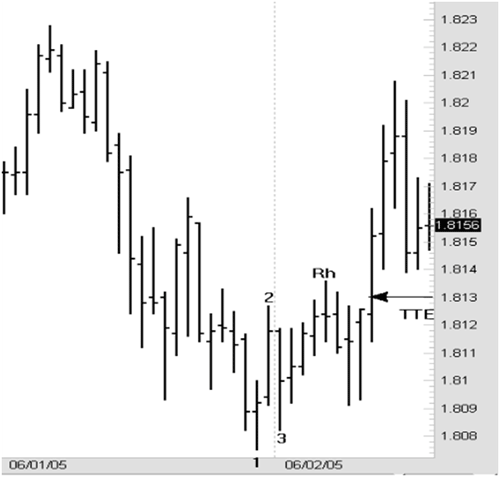
Investmentwissen - gepaart mit Tradingwissen. Mit viel Erfahrung aus dem Echtgeldhandel unterlegt.


BEARISH DOWNTRENDS
Joe Ross (Newsletter No. 504)
A bearish downtrend move begins with increased daily-range price bars, gaps, or both, and sharply falling prices usually breaking out below the low of the last downward retracement of an uptrend. If a downtrend begins as the breakout from consolidation, we will see increased daily range price bars, gaps, or both, and sharply falling prices, usually breaking out below the low of the consolidation, followed by a retracement back towards the consolidation, and finally confirming the move with a steady flow of downward prices.When we see that in a market, we know we are most likely at the very beginning of a bearish downtrend phase. Whereas in decades prior to the advent of the personal computer such moves could last for many week, months, or even years, modern-day markets tend to trend mostly for days or weeks. These abbreviated price moves have been titled "swings." Downtrends are basically driven by three human emotions: Fear (of missing a move); Greed (the desire for just little bit more); and Worry (that prices had become too high). It is excessive worry that leads to the panic that characterizes many downtrends. Downtrends tend to fall much faster than uptrends rise. The beginning of both uptrends and downtrends tend to be characterized by one of four types of gap, OR long bar movements. A gap is really nothing more than a long bar move, as can be seen by connecting the close of one bar to the open of the gap bar. There are four types of gaps (openings beyond the previous price bar's range, corresponding to market phases): 1. General (day to day long-bar moves or gaps); 2. Long-bar moves or breakaway gaps leaving a consolidation period; 3. Long-bar moves or runaway gaps (vertical or panic markets occurrences); and 4. Long-bar moves or exhaustion gaps, which end the distribution or accumulation phases.
Yours,
Joe Ross
Stories/Articles/Text Summary 2014
(Trading Educators all rights reserved)
What Is Containment? Part 4 - Containment with Bollinger Bands
Joe Ross (Newsletter No. 500)
Attempts to show trend containment most likely began with moving average bands. Traders would take a moving average of the highs and a moving average of the lows, and plot them to show containment of a trend. The problem was "How many bars should you use for the moving average?" A lesser problem developed as to which kind of moving average to use: Simple, Exponential, somehow weighted, or displaced -- which? Did it matter? Not really. The accuracy, if any, came from choosing the correct number of bars (candles) to include in the moving average.Someone got the brilliant idea to use the number of bars in a commodity's cycle -- whatever that was. However, if the cycle was too long, then it became popular to use the commodity's half-cycle. Let's face it, these were nothing more than guesses And what about things that weren't commodities, things for which finding a cycle could be extremely difficult? Were currencies cyclical? Were stocks and bonds cyclical? Did anyone really know? Do stocks have cycles? Maybe sectors have cycles. Would a natural gas cycle be the same as a crude oil cycle? I'll leave such decisions to scientists and mathematicians to figure out. While they are figuring it out, I'd rather figure out how to take money from the markets.An improvement was definitely needed, and sure enough one came along. The Keltner Channel is one of the attempts to improve containment. Instead of using moving averages of the highs and lows, Keltner decided to take a moving average of the closes, and then place the bands at a certain percentage distant from the moving average. Again, it didn't much matter which kind of moving average was used. The problem with Keltner channels is which percentage to use. Should the bands be located 10% above and below the moving average? What about 20%; 30%; or should we simply guess by trial and error?I am not telling you any of this in order to disparage or make fun of these attempts to show containment. I won't even make fun of Andrews' Pitchfork. Believe me, I used and tried them all. I made money with them, as well. But most of what I made was due to learning how to trade; learning how the markets worked; discovering the Law of Charts, and Market Dynamics.Sometime back in the 1980s, before it was bought out by CNBC, there was a TV station called FNN (Financial News Network). One of the regulars was a fellow by the name of John Bollinger. I don't know if it was coincidence, but at the time CNBC took over FNN, I no longer saw Bollinger. But shortly thereafter, I heard about Bollinger Bands. I examined them, and discovered the most intelligent way to use a moving average I have seen so far. Bollinger's idea was to allow market volatility to decide the distance the bands should be from the moving average. Bollinger's bands use Standard Deviation to set the distance of the bands from the moving average. The original weakness is still there. That weakness is how many bars (candles) to use for the moving average, along with the lesser problem of which kind of moving average to use. Nevertheless, Bollinger Bands make more sense than anything else I've seen in all my years of trading. My hat is off to John Bollinger!I have always used Bollinger Bands in the plain vanilla way that they are presented in the software I use: an 18-bar simple moving average of the close, with the bands set at 2 Standard Deviations from the moving average. I work around any weaknesses rather than trying to tweak any of the settings to create a best fit, or optimize results in any way.Notice that when prices are falling, the trend line is the lower band, which hugs the closes. With falling prices, the band most distant from the closes is the volatility band. Conversely, when prices are rising, the trend line becomes the upper band, and the lower band shows volatility. The bands expand and contract as volatility changes. We are looking at a chart of the Dow futures. How to trade with the bands is the subject of one of my mini seminars, "Trading with More Special Setups."
Yours,
Joe Ross
DON'T OVERDO IT
Joe Ross (Newsletter No. 501)
If you're like most traders, you are in this business to make money - big money. In all probability, you are ambitious, independent minded, and ready to take on the world. With this ambition usually comes a need to be the best.Only the people at the top of the field achieve the highest level of success. Although striving for expertise is a prerequisite for success, it usually coincides with a need to be perfect, and a fear of failure. If you are too much of a perfectionist, you may fear being wrong, losing money, or missing an important trading opportunity. Ironically, if you strive for extreme perfectionism, you may choke under the strain.In our status-oriented society, we often work under the assumption that we must be thoroughly competent, adequate, and achieving. We tend to believe that if we make a mistake, we will be punished. The development of this belief is understandable. As we grow up, whether it is at home, school or work, we often face adverse consequences for not being scrupulously proficient in everything that we do. But holding such a belief produces fear and anxiety, which for traders often produces hesitation and self-doubt. In addition, if we believe that we must always be competent, we will expend all our precious mental energy mulling over the negative consequences of failing, rather than focusing on what we are doing in the here-and-now to implement our current trading plan.Traders who believe they must be thoroughly competent spend all their time worrying about what they did wrong, what may go wrong, and how they will recover should they fail. These thoughts are distracting, and obscure the flow of immediate experience and the ability to read current market activity with unfailing accuracy.For your long-term, enduring success, it is vital that you learn to ease up. You don't have to be perfect. You are bound to make mistakes occasionally, and if you are consumed with avoiding them, you'll be so anxious and fearful that you will make even more mistakes. In addition, trading isn't exactly a science.Even when you think a trading plan through carefully, you can't account for every possibility. An unexpected event may ruin your plan, and there is nothing you could have done about it but manage your risk and chalk up it to fate.Sure, you don't want to make too many mistakes, but you can make a few occasionally with little repercussion. Striving for perfectionism is an important ideal to hold, but don't forget that it is just an ideal. You might try to reach for it, but don't beat yourself up when you don't get there. All you can do in the end is do your best, and keep building up your trading skills. If you keep trying to excel, but stay realistic, you'll eventually achieve lasting success.
Yours,
Joe Ross
What are Oscillators?
Joe Ross (Newsletter No. 501)
Lots of traders use oscillators, also known as indicators. Lately I've been showing you ways of viewing the containment of prices. All these ways have been based on moving averages. However, moving averages are also used to create oscillators. Most of the studies we call indicators are nothing more than oscillators, which, in turn, are nothing more than detrended moving averages. They also suffer from the same weaknesses as moving averages in that they are subject to a guess as to how many bars or candles to include in the moving average, and to a lesser degree, which kind of moving average to use.In my book "Trading the Ross Hook," I showed several ways my students are using indicators. But I also included a chapter about "Plain Vanilla" trading --trading without indicators of any kind -- something I still do to this day. In fact, most of my trading is done without indicators.Nevertheless, an indicator can be helpful in certain situations. If the price action is taken as the primary reason for a trade, that price action can often be confirmed by using an oscillator. (From this point on, "oscillator" and "indicator" will be synonymous).Most oscillators are nothing more than detrended moving averages, and they pretty much measure the same thing -- momentum. MACD, Stochastics, RSI, %R, DEMA, and others, are all momentum indicators. The differences are in how they are calculated based on an underlying detrended moving average.The moving average can be simple, exponential, or in some way weighted, but it is still a moving average, and it still has the same weaknesses -- how many bars to use, and which type of moving average to use.Note: A displaced moving average oscillator, DPO, is not a momentum indicator.Oscillators have a problem associated with them which complicates matters, and that problem is how they should oscillate: should they oscillate on a fixed scale? or on no scale at all? with no limit as to how high they can rise, or how low they can fall?The indicator known as CCI (Commodity Channel Index) oscillates with no limit as to how high or low it can go. However, CCI is primarily a volatility indicator. The creator of CCI, a fellow named "Lambert," placed it so that it displays as an oscillator. He could just as easily have placed it so that it displayed along with prices, much as do Bollinger Bands. Notice the difference between Bollinger Bands and CCI:BBs are computed as the Standard Deviation of today's close relative to a moving average of closes.CCIs are computed as the Mean Deviation of today's typical price relative to a moving average of typical prices. (Typical price can be the high plus the low, divided by 2; the high plus the low plus the close, divided by 3; or the high plus the low, plus the close, plus the open, divided by 4).Plotted in the same way as BBs, CCI would produce something quite similar to a BB display. Conversely, BBs, if plotted as an oscillator, would produce a display quite similar to that of CCI.One of the most inane things we see at Trading Educators is confirmation of one momentum indicator by another momentum indicator. Traders will put up a Stochastic, an RSI, and a %R, and excitedly proclaim that they are in agreement, therefore a signal to trade is in existence. Excuse my rant, but they are all momentum indicators. They are supposed to agree. In order to achieve any kind of confirmation value from multiple indicators, use a momentum indicator in combination with a volatility indicator.The chart below shows how a momentum indicator (MACD) combined with a Volatility indicator (BBs), can give confirmation for a move based on what a trader sees in the price action. The settings for both are standard settings. I marked a couple of places where price action was confirmed by the indicator combination. I'll leave the rest up to you.If you want to see how we trade a combination of Stochastics with Bollinger Bands, along with the appropriate settings, sign up for our mini seminar, "Trading with More Special Setups."
Yours,
Joe Ross
Accumulation and Distribution
Joe Ross (Newsletter No. 502)
The terms sound simple, but there's a bit more involved than meets the eye.It is difficult to say where the terms originated. They are used in the stock market and also in the futures markets, especially in regard to commodities. There are four market phases containing all price action. In this issue of Chart Scan we look at two of the phases: Accumulation and Distribution.The accumulation phase tends to have relatively low range from high to low, relatively low volume, and occurs at the bottoms of a prolonged bear market. Periods of accumulation are often marked by wild price gyrations, false rallies, and bull traps.We may be seeing such a situation in gold, which seems to be displaying bottoming action on the weekly chart, as 2013 draws to an end. This action, if it holds, will bring about an end to a long-term, multi-year downtrend. I have seen a six-year accumulation in the shares of a single company. The distribution phase has wide range price bars of extreme volatility, where the traders, who accumulated the underlying at the bottom, distribute it to the less informed public. Distribution phases generally are shorter than phases of accumulation. They often begin with parabolic explosions and blow-off tops. Following wild gyrations, prices settle down somewhat, and begin to move sideways. On the weekly soybean chart below we see a rather lengthy period of distribution --one that could easily go either way -- resulting in a new uptrend, or a downtrend.
Yours,
Joe Ross
CONTROLLING IMPULSES
Joe Ross (Newsletter No. 500)
When it comes to protecting your money, one of the biggest dangers is so-called impulse trading. Resisting the urge to have something right then and there is a skill everyone needs to learn in order to build a strong financial foundation.Recently I watched an entertaining TV show called "Auction Kings." One of the pieces being auctioned off was a 1975 Cadillac Eldorado. Cars don't get much bigger than those boats! The car was once owned by Elvis Presley himself, albeit only for around four months. The person selling the car was a celebrity collector who tracked down the vehicle and had owned it for the past twelve years.Besides the previous ownership documentation, there was nothing else to signify the "King" once owned the car. There were no special Elvis monograms or autographs. No custom work done to the car. No vanity "ELVIS" license plate. It was just your run-of-the-mill '75 Eldorado with a famous previous owner. In any case, the seller was hoping to get $12K at auction, and the furious bidding ended up hitting $16.5K I believe. Two rival bidders locked horns at the end, shooting the price up much higher than anticipated. When they interviewed the winning bidder afterwards, he said he originally had no plans to bid on the item. He simply got excited, got caught up in the moment, and decided he wanted to own that car.This is a great example of how quickly - and many times unintentionally - people can spend large sums of money. Take your car into the dealer for a regular service, and the next thing you know, you're walking out with keys to a new car. Here's a tip: avoid going to the car dealer for service unless you have to. Find a good and trustworthy mechanic so you can avoid the temptation to spend when you don't need to. Everyone has his own special weaknesses when it comes to spending money. For some, it's classic automobiles. For others, it's luxury handbags. Whatever your Achilles heel is, you'd better put "stop-loss"-like procedures in place to avoid buying short-term euphoria and long-term debt. You've worked hard, so you should certainly treat yourself to some of the good things in life. Just try to prioritize what those things are. Try scheduling your purchases to avoid impulse buys. Give yourself something great to look forward to in the future, instead of being constantly lured into that next big purchase. The money you'll save can then be put into income-producing assets like high-quality dividend-paying stocks. How to do that is the topic of my e-book, "Money Master."
Yours,
Joe Ross
COOL AND PROFITABLE
Joe Ross (Newsletter No. 502)
While risking capital on a trade, it's hard to not feel a little cautious. After all, if this trade, the next trade, and the one after that are losers, you'll begin wondering about what you might be doing wrong. You might feel a bit desperate, and think of trying to regain your edge.Feeling uneasy after a series of losses is understandable. But experienced traders keep cool, even when they are in a drawdown. They aren't riddled with self-doubt. They don't question their trading strategy. They just wait for the market to move in their favor, put on the trade, and exit. It's effortless, almost easy. But if you're an inexperienced trader, cultivating a carefree mindset isn't as simple as it sounds.At first glance, it seems easy to follow the advice of master traders on how to trade carefree: Make small trades that have minimal consequences to your account balance should you lose. Objectify the trade. Pretend it doesn't matter, and force yourself to think of the big picture. Think optimistically: "I'll make enough trades to see a profit. I'll just keep my chin up, chalk up losses to misfortune, and keep trading. Eventually I'll see a profit." However, many wannabe traders have trouble staying optimistic.You don't accumulate enough trading capital to trade full time by taking unnecessary risks, and to the novice trader, trading can take on the aura of throwing away hard-earned money with little reason. It can be difficult to just forget about the money.Most of us live in a rule-driven society. At work especially, we live by following conditional statements: If I do job task X, Y, and Z, then I'll get a reward. The more effort I put in, and the harder I work, the greater the rewards become.It's like an assembly line approach to work: I'll bolt on my required number of wheels a day, and thereby earn my daily wage.Making more money is a matter of willpower. If you can force yourself to work longer hours, you'll make more money. Such a strategy often works in white-collar jobs as well as blue-collar jobs, and it is natural to assume that merely following if-then reward contingencies in trading leads to sure profits. It's tempting to think that if you just spend more time mulling over a trade, thinking long and hard enough, you'll account for every possibility. Similarly, if you search over and over again, you'll find the ultimate trading opportunity. It makes sense, but in reality it doesn't work that way.Seasoned traders report that they make the most profits when they aren't expecting them. They observe the markets openly and freely, and suddenly they make a profitable trade. If you put pressure on yourself, however, you usually choke. Your mind isn't free, but cluttered with feelings of doubt and pressures to succeed. The frustration distracts you, and suddenly you find it almost impossible to make enough winning trades to come out ahead.It's much more important to cultivate a carefree mindset. Don't put pressure on yourself, and don't think about the money. Many profitable traders don't focus on the money. In some ways, they have a disregard for money. To the professional, seasoned trader, the money is just a way to keep score. It isn't an end in itself. To the experienced trader, trading is a contest. You enter the contest, and if you rise to meet the challenge, you score more points. In this case, the points are represented in terms of money, but they are just points.Winning traders focus on the enjoyment they derive from trading. This approach to trading allows them to think clearly and freely. By cultivating a carefree attitude, they remain cool and profitable.
Yours,
Joe Ross

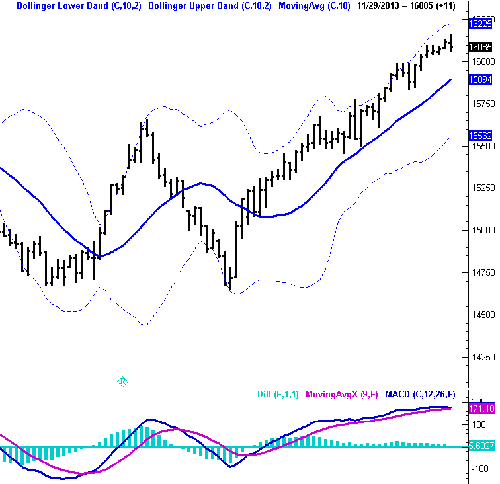
A FRESH START
Joe Ross (Newsletter No. 503)
Have you ever been stuck in a rut? All you can think about is how "behind" you are, and how hard it will be to come back. Maybe you're thinking "I haven't made enough winning trades. What am I going to do? I'll never make it back."It's natural to panic a little when you're first starting out as a trader. The anxiety and worry can get to you, but winning traders have a trick that you may find helpful: they compartmentalize their trades. They take things one trade at a time, and view each trade as a completely new opportunity. By focusing on their immediate experience, and staying fresh, they stay optimistic and full of energy.There's a strong urge to contemplate the past and worry about the future. It seems wise to do so, but looking at your past often gets you nowhere, especially in trading. And excessive worry about the future often distracts you from what you need to do right now in order to ensure future success. While you're worrying, you aren't focusing on current market conditions. You aren't sharpening your trading skills in preparation for future market opportunities. Worrying about the future is a complete waste of time.Seasoned traders compartmentalize. They put each trade into a different mental compartment. With each trade they make, they start fresh. They don't worry about where they have been, or how bad they'll feel should the trade be a loser. Instead, they focus all their energy on their immediate experience, what they're doing at the moment, and what they need to do next to implement their trading plan. By focusing solely on the trade in front of them, they stay calm and relaxed. They are focused "in the zone," the same way an athlete concentrates on making a play, or a rock climber cautiously takes the next step. There's no time or energy for worry. It is distracting, and can lead to a downfall.Obviously, it's hard to not worry about the future. Indeed, it's important to be concerned about losses, and to carefully manage risk. Also, if you are in a serious drawdown and unsure of how to get out of it, it is essential to go out of your way to make plans for getting yourself out of trouble. But you don't have to worry about these issues while executing your trading plan. If you have to worry about the future (and you never have to worry if you're always planning and taking decisive action), do it off-hours, not while you're trying to execute your trading plan!In addition, don't mentally string trades together. Treat each trade as an emotionally independent event. If you tie a string of losses together, for example, you'll start to feel upset, and your past losses will impact your ability to make future wins. Even when you're "on a roll," and relishing the glory of a winning streak, you will be thrown off track when an unexpected loss crops up. You'll let it interfere with what you need to do right now in order to continue winning.There's no one right way to trade. Certain mental strategies work for some traders, but not for others. That said, many seasoned professional traders find it useful to start each new trade as if it were a new day. They think positively, as if anything is possible. The next trade may be a winner or it may be a loser. Whatever the outcome, though, they celebrate a victory, or take a loss in stride, and just move on. And, in the end, they are profitable.
Yours,
Joe Ross
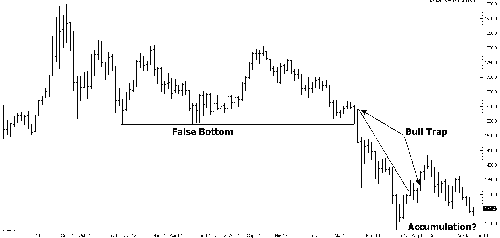
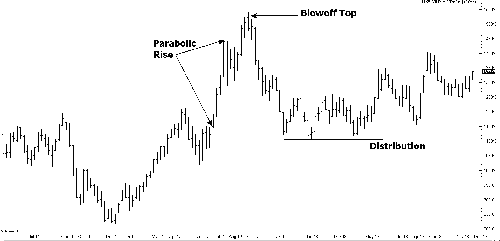
WAITING FOR THE PAYOFF
Joe Ross (Newsletter No. 504)
Are you ready to work all day and make absolutely no money at all? If you ask most people who are accustomed to working a 9-to-5 job, they would say, "No way, are you kidding?" But if you are a serious, active trader, there are many days that you must accept the fact that you aren't going to take home any money. There are various reasons that might cause you to decide to work for no immediate payoff. For example, market conditions may not be optimal, and should you try to trade under such conditions, you might end up actually losing money.On another day you might be tired, overly anxious, or just feeling awful. If you were to trade with less than an optimal mindset, you could make trading errors that have lasting repercussions. Sometimes you need to merely study the markets to figure out what's going on, and what mode the markets are in.At other times, you may just want to read up on new trading methods to stay ahead of the crowd. There are still other times when you need to intensely focus on learning new methods and building new skills rather than on trying to gain an immediate profit.Experienced, active traders look at their profession quite differently from how many people view their typical blue- or white-collar jobs. It's a creative job where part of the skill is the ability to intuitively get a feel for the markets, and understand when they should push themselves and when they should stand aside to wait for better times.Spending time that doesn't lead directly to an immediate payoff is hard for many people to accept. Many people are used to making an hourly, weekly, or monthly wage. But in the trading business, you have to think about things differently. You can't focus on taking home a steady paycheck. Consider what would happen if you inflexibly thought you had to take home a target profit of $200 day. It's quite likely that on many days you would work for a solid eight hours without realizing a profit. If you work under the assumption that it is critically necessary to reach the $200 goal each and every single day, it's likely that you may start wondering how you'd meet your expectations in the last 30 minutes of the session, and feel a need to get there no matter what.While under pressure, you might take low probability setups or impulsively make trading errors. The end result could be substantial losses that you would need to make up the next day. Rather than making the $200 profit, you could be down $200. You would have been better off standing aside that day.Trading is a profession in which you have to think freely and creatively. Yes, you can push yourself to your limits while studying the markets off-hours, but during the trading day you have to stay calm and open to your intuition. You have to work with current market conditions, and use your talents to take out profits. Sometimes those profits are huge. At other times you won't make anything. But it's all right, your overall profits are all that matters, not what happens on any given day. So when you have those days when things don't seem to be going your way, don't get upset or disappointed. If you patiently wait for the markets to move in your favor, you can apply your specific talents to making a profit. It's just a matter of going where the markets take you.
Yours,
Joe Ross
BULLISH UPTRENDS
Joe Ross (Newsletter No. 503)
A bullish uptrend move begins with increased daily-range price bars, gaps, or both, and sharply rising prices usually breaking out above the high of the last upward retracement of a downtrend. If an uptrend begins as the breakout from consolidation, we will see increased daily range price bars, gaps, or both, and sharply rising prices, usually breaking out above the high of the consolidation, followed by a retracement back towards the consolidation, and finally confirming the move with a steady flow of upward prices.When we see that in a market, we know we are in a bullish uptrend phase, most likely at the very beginning.In decades prior to the advent of the personal computer such moves could last for many week, months, or even years, but modern-day markets tend to trend mostly for days or weeks. These abbreviated price moves have been titled "swings." Uptrends are basically driven by three human emotions: Fear (of missing a move); Greed (the desire for just little bit more); and Worry (are prices becoming too high)? It is worry that eventually leads to the panic that characterizes downtrends. We will look at bearish downtrends in the next issue of Chart Scan.
Yours,
Joe Ross
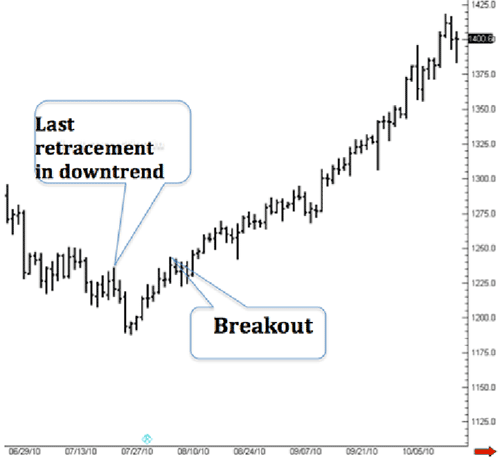

CHECKING YOUR PERFORMANCE
Joe Ross (Newsletter No. 508)
How good a trader are you? Everyone eventually must ask and answer this question. The answer may be unpleasant, but sooner or later you have to face your limitations. Some traders feed their accounts every month to avoid looking at how poorly they are doing. It's natural to take such measures. We all want to be successful, and it can be devastating to discover that, despite our best efforts, we just aren't trading up to par. Yes, it takes time to hone your trading skills, but if you are losing money every month you must be doing something wrong. Why not change to doing something right, and start taking home huge profits?It is vital to monitor your trading performance on a trade-by-trade basis. Keep a trading diary. Record the setup, your trading plan, and how confident you felt about your plan. And more important, it is useful to keep track of your dollar-based win-loss ratio. There are many ratios that you could use to gauge your performance, but a win-loss ratio based on dollar amounts is a useful marker of performance.It's simple to calculate if you keep records. Always record the dollars won or lost on each trade, then divide the dollars won by the dollars lost. (You could use a simple win-loss ratio comparing winning trades to losing trades, but if you ignore the dollar amounts, it's possible to obtain a reasonable win-loss ratio, but still mount substantial losses.)If your dollar-based win-loss ratio is 100% or lower, you are bound to blow out your account over time. In order to survive, you must increase the ratio. Seasoned traders tend to have a ratio of 200% (in other words, for every dollar they lose, they win $2). Some professionals have a ratio of 400%.Why do some traders have low win-loss ratios? One of the reasons is that they don't look at the potential risk before they make a trade. They take setups that are overly risky and unlikely to produce a profit.Rather than take the trade, they would be better off waiting for a better trading opportunity, a trade setup that potentially could provide larger profits and little risk. It's not easy. It takes patience, and a strong commitment to study the markets and identify good setups.But in the end, it's worth it. If you carefully select high probability setups, you'll trade more profitably and you'll be more satisfied with your performance. Suddenly, you'll find that you'll get on a roll and your profits will increase greatly over time. By carefully monitoring your performance and managing your risk, you'll see your profits reach new highs.
Five steps to becoming a successful trader:
1. Focus on trading vehicles, strategies, and time horizons that suit your personality. You need to be comfortable with them.
2. Identify non-random price behavior wherever you can find it.
3. Absolutely convince yourself that what you have found is statistically valid.
4. Set up trading rules.
5. Follow the rules, but don't be afraid to break them if they don't work.
I know all this sounds simple, but as soon as you start applying it the simplicity is gone. Especially step number 5, which is tricky because many traders are not at all used to following rules in the first place, and so might not recognize when it is appropriate to break them.If you want to look over the shoulder of an experienced trader to see how the rules mentioned above are placed into action, you might join us in the new Live Trading Room in which we trade the most popular markets: E-Mini S&P (ES), E-Mini NASDAQ (NQ), Mini DOW (YM), and the Mini Russell (TF). All trades are absolutely live, showing all parts of the trades such as entry, stop, and exit. We discuss every aspect of the trade, from the set up to the close. We use modern technology, and you can see everything the trader is doing in real time.
Yours,
Joe Ross
A BIT OF CHART ANALYSIS - THE POINT OF A ROSS HOOK
Joe Ross (Newsletter No. 505)
I love to remove identifying information from charts, so that you can see that a chart is a chart, regardless of what it is, when it happened, or even in which time frame what you see took place. Prices were moving down in July. In August there was an end to selling, which was the low at point 1. As prices started to rise, shorts began to cover in order to take profits. Their buying, aided and abetted by the entry of longs who thought "this is the bottom," caused prices to rise to the number 2 point.Some longs, looking for a quick profit, began to sell: Those longs were joined by traders who felt that what they were seeing was a minor market rally.Then prices headed back down to the number 3 point.However, there was not enough supply at the low prices to warrant continued selling, and demand took the market higher. As prices rose, selling came into the market as longs liquidated all or part of their position, forming a Ross Hook.The market violated the point of the Ross Hook, and a new uptrend was established.Prices were moving up, and several retracements took place. These retracements were caused by longs taking profits. To cover their positions, they sold, thereby causing the market to retrace. The corrections left behind a minor or intermediate high, which we call the point of the Ross Hook.
Yours,
Joe Ross
MAKING A CHOICE
Joe Ross (Newsletter No. 505)
Would you rather have a job that pays a low salary but provides a steady income, or a high-paying job that might not be around next year? The answer to this question reveals a lot about your preferred trading style.If you are like most short-term active traders, you don't mind exchanging a little bit of security for a higher salary. Compared with typical jobs, short-term trading is risky, and one of the main factors influencing your preference for risk is your overall feeling of confidence and security.If your overall confidence is easily compromised, and if you strongly need to feel safe and secure, you'll have difficulty trading in the short term. You'll often feel anxious and uneasy. Can you build up risk tolerance? Yes, but it depends on your psychological makeup. The need for security is often based on early childhood experiences, and for some traders can be difficult to change.Money and security go hand in hand. The more money we have, the more easily we can acquire food and shelter. When our money is on the line, it's understandable to also think that our sense of safety and security is on the line. What is a mere monetary loss to some people can feel like a threat to safety and security to others.Losses take on a greater personal significance when your self-confidence is on shaky ground. For some traders, self-doubt, fear, and uncertainty may go back to the early bond formed between parent and child.Early parent-child relationships can shape people's expectations, especially the extent to which a person feels safe and secure. Many people who feel confident and secure tended to have parents who provided what psychologists call a "secure base." Parents and loved ones were dependable, reliable, and available. This allowed the child to explore the uncertain and terrifying outside world in a carefree manner. They knew that if they encountered fear, they could quickly return to their "secure base" to gain comfort and safety.Other children felt less safe and secure. Their parents were less caring and reliable, and thus they were fearful of leaving their parents' side because they didn't believe their parents would be there when they returned. They were afraid to venture out, did not learn to cope with uncertainty, and in adult life tend to unrealistically expect failure and rejection. Taking risks as adults is especially fearful.People who are the most comfortable in taking risks almost always felt safe as children and as adults. It's as if they feel significant loved ones are always there with them to provide safety and support. That said, there are also risk-seeking gamblers. People who had parents who were psychologically absent also take risks. They tend to have a "who cares" approach to life. They may be able to take risks, but they don't have the discipline to develop specific plans and follow them. Many people fall somewhere in the middle. They can take a few risks, but they are often undisciplined. The lack of discipline usually reflects fear. They fear loss and hurt, and over-react to setbacks. A losing trade has greater symbolic meaning: it is a loss of safety and security.If you have low risk tolerance, how do you beat it? First, you have to be realistic. If you are afraid to take risks because money represents safety and security, you'll have to make small trades and manage them carefully.Second, you may also have to adjust your trading style to match your personality. Some people with major risk tolerance issues prefer long-term investing; when done properly, it can be less risky. You can identify markets that are relatively stable and trend over the long term. You won't make as much with this approach, but your emotions won't be as wobbly.You'll feel calmer, and enjoy trading the markets. Third, you may want to work a stable job on the side to pay basic living expenses. If you know that your basic living expenses are relatively secure, you'll feel more comfortable in being a part time trader.Winning traders have high levels of risk tolerance. If you have trouble taking risks, you'll have trouble trading the choppy, volatile markets in the short term. You won't feel comfortable, calm, and secure. And you'll likely make trading errors. But that doesn't mean you have to stop trading. You just need to be aware of your personality and work around it. If you match your trading style to your personality, you'll make profits in the end.
Yours,
Joe Ross
CUT YOUR LOSSES
Joe Ross (Newsletter No. 506)
In trading, it's not whether you win or lose, but how much you profit on a winning trade compared with how much you lose on a losing trade. If you can cut your losses and move on, you'll survive. It makes sense, logically, but psychologically, many traders have trouble cutting their losses. We hate to lose, and we will do almost anything to avoid losing, even it means denying that we've lost. Some are happy to keep losses on paper to avoid the inevitable feelings of regret that often come with a losing trade. People are risk averse. They often sell off winners too prematurely, and keep losers too long, hoping that somehow things will turn around. But it hardly ever works. Many people would be wise to follow the advice of Paul Tudor Jones: "I spend my day trying to make myself as happy and relaxed as I can be. If I have positions going against me, I get right out. If they are going for me, I keep them." It's vital for your long-term survival that you admit that you have made a losing trade, and close it out.Humans have a natural inclination to avoid losses, but seasoned, profitable traders cut their losses early. They work under the assumption that they might see many more losing trades than winning trades. Knowing how to take a loss in stride is a key skill that all traders must develop. It's often easier said than done. Behavioral economists have outlined many mental processes that prevent most traders from accepting a loss and moving on.First, as humans we are naturally risk averse. We don't like taking losses.When it comes to "a sure win," they take it immediately. But when it comes to a sure loss, they would rather take a chance, hope for no loss at all, and possibly take a larger loss than just taking the small loss up front. Both professionals and amateurs can fall prey to this tendency. Trading lore is replete with tales of traders who just couldn't take a small loss immediately. They hold on to losses rather than admit they made a big mistake. The losses continue to mount, and the hole gets deeper and deeper.The human mind has a remarkable capacity to ignore what it doesn't want to see. And losses are hard to see. Second, a major psychological reason for holding on to a losing trade is the sunk-cost effect. The more financial and psychological costs we sink into a trade, the harder it is to take the loss and move on. It's like thinking, "I've waited so long and I've lost so much of my initial stake that I can't give up now."There's a strong need to justify the effort and expense you have put into holding a losing position. The psychological need to justify the loss is so great that it can be difficult to write it off.Third, social processes prevent many traders from taking a loss. It's hard for some traders to keep their wins and losses to themselves. Trading can be a lonely profession. It might be useful to join a network of friends to share experiences and get support. The downside, however, is that some people in the network may compete with you, just waiting for you to have a setback so that they can feel superior.You may look forward to relishing your wins, but dread having to admit your losses. The need to save face can prevent some traders from taking a loss. The best antidote to this problem is to stay humble and away from chat rooms. Don't brag about your wins. If you avoid getting a swelled head, you'll be able to admit your mistakes and shortcomings more easily, and you won't worry about becoming embarrassed for losing.Cutting your losses is vital for success, but it's hard to do. Be aware of the powerful psychological factors that prevent you from taking a loss and moving on. It may be hard to do, but if you work under the assumptions that losses are inevitable, and don't take losses personally, you'll be able to cut your losses, move on, and make huge profits.
Yours,
Joe Ross
ANTICIPATING BREAKOUT
Joe Ross (Newsletter No. 506)
l love to remove identifying information from charts, so that you can see that a chart is a chart, regardless of what it is, when it happened, or even in which time frame what you see took place. The lesson we want to gain from the example below is how to anticipate the direction of a breakout from an area of consolidation - in this case a rather sloppy-looking congestion.Notice that shortly after prices began to move sideways, at the end of the trend they formed a 1-2-3 formation.However, prices failed to violate the #2 point. Instead, they moved into a tight consolidation containing too many price bars to be considered a ledge (10 bars). Within the congested area, a second 1-2-3 formed. This was followed by a Ross Hook (Rh).In anticipation of a breakout to the upside, a buy stop should have been placed as shown. The second 1-2-3 formation defined a trend. The Rh established the trend. A few bars later, a second Ross hook formed. If you were trading based on this chart, you might have considered placing a buy order as shown just above the high. A buy order there constitutes engaging in a Traders Trick entry.
Yours,
Joe Ross
CONFLUENCE
Joe Ross (Newsletter No. 508)
There are numerous ways to measure price action. These measurements are used by technicians who want to believe that prices move mathematically rather than based on human emotions. They therefore try to contain prices within mathematical rules. Of course, price movements are neither mathematical, nor are they logical.Nevertheless, when enough traders who are in the market are trading according to whatever mathematical theory they follow, their actions cause prices to become somewhat self-fulfilling.There are different schools of thought about how to measure price action. There are those who believe in Gann theory, those who believe in Fibonacci theory, those who believe in Elliott Wave theory, and those who believe in the Golden Ratio. There are probably other theories as well. Notice that all of these are theories, none of them are facts!The different ways they measure cause them to act when certain price levels are reached. Their measurements tend to fall quite close to each other, and those areas where these theorists buy or sell are called areas of confluence. Is "H" a 50% retracement of "A-B?" Is it a 50% retracement of "A-D?" or is "G-H" an expansion of "E-G?"Is "D" an expansion of "B-C?" Is "D-E" a .382 retracement of "A-B" or a 1/3rd retracement of "A-D?"What about "G?" is it a 50% retracement of "D-E?" or is "D-E" a .382 retracement of "A-D?"Are we looking at a series of Elliott Waves? Is "A-B" a wave "1?" or is "A-D" wave "1?" Is the series "D-E", "E-G", "G-H", an "ABC" retracement of "A-D," which is really a correction of wave "1" i.e. "A-D."What are "I," "J," and "K?" Is "K" a .618 expansion of "D-H?" or is it a "2/3rd" expansion of "D-H?"Do you still have your sanity? I could have described it all in a completely different manner. If there is an area of confluence it would seem to be "H." Gann, Elliott, Fibonacci, and Golden Rule theorists would probably have considered "H" to be a 50% retracement of something or is it simply a major turning point?Of course, "H" may be nothing at all in a different time frame. For example: If the chart above is a 60-minute chart, would "H" turn out to be anything at all on a weekly chart?
Yours,
Joe Ross
DOES A MOMENTUM INDICATOR TELL THE TRUTH?
Joe Ross (Newsletter No. 509)
Can you know what is going on based on a momentum indicator? Is it possible for a momentum indicator to predict the future? Can you use a momentum indicator for confirmation? When do momentum indicators work best? Notice the 3 indicators on the chart below. When prices were moving sideways, Stochastics gave the best signals. It peaked earlier than either RSI or MACD. Stochastics and RSI both picked the bottom prior to the uptrend sooner than did MACD. MACD seems to always come late during sideways moves.However, once price began to trend, especially when they broke above the previous high, Stochastics and RSI were virtually worthless. MACD did the best job of following the trend.Keep in mind that no indicator can predict the future. All indicators do not register until something happens to prices. Yes, I know, I know that divergence often points towards a trend change. But divergence never gives you the timing as to when the change will take place. Indicators can diverge from prices for a long time before prices actually stop trending. Notice that not a single indicator diverged in time to catch the last retracement prior to the resumption of the uptrend at the end of the chart.You can use any of these indicators for confirmation of what you see happening with prices. All of them can help you make more precise entries and exits, but notice one enormous weakness of all indicators -- how many bars is the correct number of bars to use for the moving average?Indicators of the oscillating kind, as are Stochastics, RSI, and MACD, all depend for their accuracy on the number of bars placed into the moving average. All of them are nothing more than detrended moving averages. In the case below, I used 12 for the number of bars or candles in the moving average. I used 12 only because it was the default for MACD on the software I use (Genesis Trade Navigator). Is there a correct number of bars to use for the moving average? The only way to tell is to set the number of bars to a value that seems to give a best fit for the current price action.Your focus should be on prices, not on indicators. The reason traders use indicators is because they never learn how to read a price chart. Indicators are a crutch, and an almost certain way to lose is to trade based on indicators as the primary issuer of signals rather than to trade based on prices.
Yours,
Joe Ross
APPRECIATING THE BEAUTY OF THE MARKETS
Joe Ross (Newsletter No. 507)
Have you ever had one of those days in which you wished you had stayed in bed rather than executed your first trade of the day? Perhaps you excitedly put together a trading plan the night before, only to get a poor fill when the markets opened the next morning. Maybe you were just in a bad mood and frustrated that nothing was going right. Some trading experts warn against trading while upset or frustrated - it might make you prone to making mistakes. Many times, it's better to just stand aside. But walking away can make you feel as if you have been defeated. And if you stand aside too often, you may feel as if you aren't giving trading your best shot. It can feel as if you are prematurely walking away from a challenge, rather than gaining new experiences or learning how to overcome new obstacles. It may not be a good idea to stubbornly try to trade under market conditions that aren't conducive to your trading style, but there is a compromise: you can move from a "doing" mode to a "being" mode. Rather than force yourself to actively trade, you can just relax and appreciate the complexity and beauty of the markets. During the trading day, and often during off-hours, we are consumed with doing whatever we can to make a profit. We plan, anticipate, and find solutions to trading problems. We search for a winning trading strategy, even if it means ineffectually coercing ourselves to find a way to profit from the market action. But trading is a creative endeavor. It's a combination of looking for historical patterns and using your intuition to decide whether history is actually going to repeat itself at this time and at this moment. When it comes to using your intuition and creative skills, you have to be free, open, and ready to accurately perceive what the markets are doing. Trading is an art. You can't force yourself to be creative. You have to let a creative idea come to you. But when you're upset, frustrated, and forcing yourself to find a winning strategy, you often choke under the pressure. You're closed off. You can't see what you need to see. When you're having a bad trading day, you can't see clearly. You can be stuck in a "doing" mode, trying to take action, and frustrated because you can't figure out what do to next. You can get caught up trying to find solutions and taking decisive action, and get mentally overloaded with details. You're overly emotional. You're frustrated and overwhelmed. When things get that bad, you just can't think clearly enough to actually take action. The solutions to problems don't come easily, and it is quite possible that you'll make mistakes. Is it time to give up? Maybe. But an alternative is to move from a "doing" mode where you are trying to take action to a "being" mode. Rather than trying to execute a trade, which is the main concern of the "doing" mode, you can try to merely observe and study the markets.Rather than try to take charge, you can be a mere observer. Rather than pushing yourself to figure out what trade to execute in the next few moments, you can settle for merely observing the markets. You can take a rest, relax, and just study the markets. When you fully commit to avoid making a trade in the next few moments, and are content with merely being a student of the markets, you'll free up mental energy. As you start to calm down, your creative juices will flow freely again. Suddenly, solutions that eluded you in the "doing" mode become obvious while in the "being" mode. You'll once again feel free and creative, and when your head is a little clearer, so are your perceptions and intuitions. Soon, you've moved from mental stagnation to "trading in the zone." So if you find yourself frustrated and stuck, and fruitlessly trying to push yourself to the limits, stop. Allow your mind to step aside. Breathe freely and relax. There are times when you have to just stop and appreciate the complexity and beauty of the markets. When you do, you'll naturally see new ways to trade freely, calmly, and profitably.
Yours,
Joe Ross
MELTDOWN
Joe Ross (Newsletter No. 507)
A few days ago, I was asked: "What is a meltdown?" My answer was," I can show you better than I can explain it." There are numerous reasons for a meltdown to occur, more than I can name here, or even remember. We have seen a meltdown caused by a "bug" in a high frequency trading program.Often a meltdown will come from a missed earnings report, in which earnings come in under expectations. Meltdowns can be caused by a sudden unexpected increase in supply, the announcement of a dividend cut, a higher than expected rise in interest rates, an unexpected political event, or an unexpected economic event. Meltdowns are usually caused by unexpected events.Meltdowns are characterized by wild sideways chopping action after the gap or long move down is completed. The meltdown may encompass more than one bar or gap.Melt-ups. A Melt-up is the opposite of a meltdown. The word is an oxymoron. Things cannot melt up. If melting is directional, the direction is surely down. But in the crazy world of trading, the melt-up has become an accepted term. The same is true for the word "correction." A so-called correction is really profit-taking. You cannot correct something that is always right. The market is always right, regardless of your opinion. If you don't understand that profit-taking causes prices to move opposite to the way they were moving, then you can always use the word "retracement." Retracement describes the way prices are moving, but it doesn't tell you why they are moving that way, as does profit-taking. If you want to see a graph of a melt-up, turn the above graph upside down.
Yours,
Joe Ross
TRADE MANAGEMENT - Stopped Out!
Joe Ross (Newsletter No. 513)
At Trading Educators, we often suggest trading at least two contracts, and preferably three. The reason for this is to use one contract to cover costs, and then allow the others to ride to a reasonable profit level. We teach never to try to take from the market, only to accept what it gives us. This differs considerably from the mind-set of most traders, who are driven by greed to seek to squeeze every last penny from each and every trade.We use a three-contract concept: one contract is cashed as soon as possible to at least cover costs and take a profit. The stops for two contracts are then pulled up to breakeven as soon as is practical. We also teach people to scalp, taking everything off as soon as the trade is profitable. It's up to the trader to decide which way works best.If managing the trade beyond a scalp trade, when the market yields a few more ticks, the second contract is cashed, thereby locking in additional profit for the trading effort. The third contract stop is held back at breakeven, or where the first profit was taken, for as long as possible to allow the trade the most room to mature.As profits are earned, a stop is trailed according to any one of a number of acceptable methods. The stop is never allowed to do any worse than breakeven. For more about stops, sign up for my e-book "Stopped Out."This management technique derives from a different attitude towards the markets than is commonly taught and practiced by the majority of teachers or coaches of trading skills.You can see where I went short, and where I took my first objective. With the markets the way they are trading, I would scalp the entire trade at that first goal. However, in order to show you an alternative method of management, I took profits on two contracts at the first profit goal and trailed a third contract one tick above the high of each bar as prices descended, until I was stopped out.
Yours,
Joe Ross
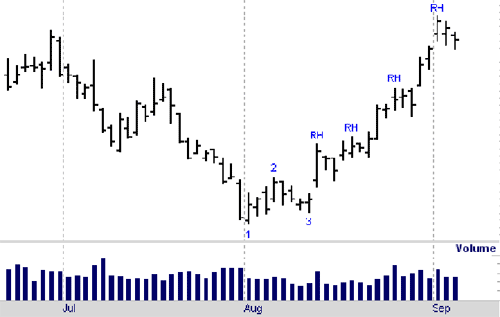
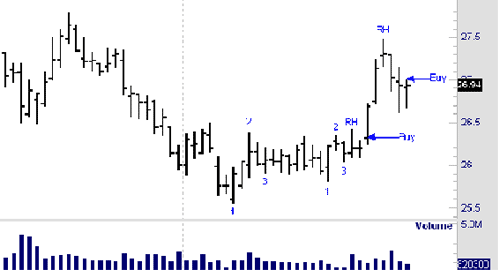
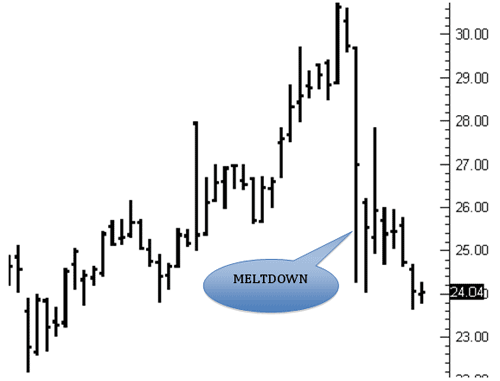
COOL
Joe Ross (Newsletter No. 510)
This morning I happened to catch a video on youtube. It was something about the coolest guy on Earth. It made me think about being cool and having your act together as a trader.Trading can be fast-paced. As an active trader, you may sift through a barrage of information from media reports to earnings statements to unexpected national events. It's sometimes hard to make sense of it all, and to see which pieces of information actually impact the markets you are trading. What will happen next is never certain. Trading plans that you developed during off-hours may not match current market action. When things don't click and fall into place in the way that you had planned, it can be stressful, confusing, and frustrating - but in all the confusion, it's important that you keep cool and organized. Rather than try to do too much with the little time and energy you have, you must stay focused.The pressure to get things done in a short time can be a significant source of stress. And when your plans don't seem to be working out, there's psychological pressure to make difficult decisions quickly.You wonder if you should stick with your current trading plans, or should you look for new opportunities? There's a need to be careful. You don't want to make a wrong decision and miss out on a rare market opportunity. When you feel that you have too much to do, and not enough time in which to do it, it grates on your nerves. Suddenly, everything can seem disorganized, unstructured, and confusing.One of the most effective ways to cope with the pressure to get more things done than you have time for, is to change your perception of time.Time perception is the degree to which people perceive their use of time as structured and as contributing to a specific goal or set of goals. When you're frustrated and unsure of what to do next, you can feel that you are moving aimlessly back and forth among alternatives and getting nowhere. It's as if you are out of control.At these times, it is necessary to return structure into your trading life. When you perceive that your time is structured and that you are working towards a specific purpose, it will help you to feel more calm and focused.When frustrated by the markets, you can become an extreme perfectionist, afraid to make a mistake and unsure which path to take. To gain control, it is necessary to set clearly defined and realistic goals, and make specific plans for how to reach these goals. When you feel especially confused, it makes sense to pick a few trading plans, and focus on implementing them. Which should you pick? Pick the ones that seem to match the current market conditions, but don't get hung up on it.Many traders make the mistake of thinking that they must choose the one right plan, or else they will miss out on the trade that "goes to the moon."That may be the case. You may have chosen a trading plan that wasn't the best, but you could be wasting more time deliberating among plans and setups than in taking decision action. Taking decisive action can restore a feeling of control and direction.Once you implement at least one of your plans, you will naturally reward yourself, and feel that you have achieved a meaningful goal. You'll feel back in control, and once again enjoy the process of trading. Everything will start to feel as if it is coming together into a whole.When you perceive your time as structured, you will feel less stress and feel more satisfied with your overall trading experience. You'll feel cool and organized, and trade more profitably.
Yours,
Joe Ross
ARE YOU IN ANY OF THESE?
Joe Ross (Newsletter No. 510)
Every so often I have to include something about spreads in an issue of Chart Scan. To me these "trade what you see" spreads are like taking candy from a baby. If you're missing out on these while you sit cross-eyed, watching a 1-minute chart, you have only yourself to blame for not picking up these easy-to-see trades.
Top left:
Upper chart > crude oil slightly rising/Lower chart > natural gas flat to falling. Spread rising.
Top right:
Upper chart > live cattle rising/Lower chart > lean hogs falling. Spread rising.
Bottom left:
Upper chart > soybeans flat to falling/Lower chart > wheat falling. Spread rising.
Bottom right:
Upper chart > wheat falling Lower chart > corn flat to falling. Spread falling.
This chart shows long wheat/short corn. To have the spread line rise, chart it as long corn/short wheat. Spread line must be rising for you to make money.
Yours,
Joe Ross
GUILT
Joe Ross (Newsletter No. 509)
In the trading profession, profits are hardly a sure thing. Even the most experienced traders make big mistakes and pay the price. Professional traders, as well as independent short-term traders, can mount huge losses. If you are experiencing a severe drawdown, don't feel badly about it. You're not the first person, and you won't be the last, to experience a severe drawdown. Emotionally, it is difficult to avoid feeling uneasy. And, depending on how severe the loss is, you may feel afraid, possibly ready to panic. Facing losses is one of the most difficult issues to deal with emotionally. If you are an active professional trader, your identity and livelihood are on the line. If you are a part-time trader, it's frustrating to feed your account from your day job, or savings, and wonder if you'll ever make back the money you've lost. Depending on your personality and experience with the market, you may have trouble handling feelings of loss, guilt, and fear. But unless you get your emotions under control, you'll never be able to get back on track. When some traders face a severe drawdown, they feel especially guilty. You can feel guilty when you break a personal moral rule. Losing money can make almost anyone feel guilty. You want to live by the rules your parents and teachers taught you, and many of them taught you to work hard and to save your money. Trading requires risking money, and to many people risking money seems to go against the values they were taught. For example, when many novice traders announce to their family and friends that they are going to become a trader, the first reaction is "You're going to lose your money." They say it as if wanting to become a trader is automatically making a big mistake. If you want to make huge profits, you're going to have to risk money, and in all likelihood you're going to lose a lot of it before you develop the skills you need to trade profitably across a variety of market conditions. Are you going to lose money? Yes. Is it morally wrong? Not from the perspective of a trader. It's vital that you identify the beliefs underlying your guilt, and change them. You must ask yourself whether your guilt is warranted. It isn't a good idea to rack up so many losses that you can't pay it back easily. If you trade money that you just can't afford to lose or will have great difficulty in paying back, you will naturally feel guilty. It is important to make sure that your losses are reasonable, and actually a temporary setback. Or, if the losses reflect a lack of skills, make sure that you can easily cover your losses from another source. It will be hard to control guilt if it realistically reflects losses that will permanently harm your financial security. If you determine that you can actually afford trading losses, and still feel guilty, you need to look at possible assumptions that may underlie your guilt.One reason is that you may have been taught that money is sacred and that it is morally wrong to risk it and lose it for any reason. Many people hold this belief, but if you want to trade actively, you have to change the way you look at money. From the perspective of the serious trader, money is merely a vehicle used to make more money. It is just part of the tools you need to trade successfully.Don't think of it as "money," but as "points" you use to keep score of how well you are doing.A second assumption that underlies guilt is the need to be perfect. You may feel guilty because you believe that you must not make trading errors or rack up losses. You may believe that if you do, you are a "bad" person, or inadequate. It is essential to avoid taking losses personally. Losses are a natural part of trading. If you are a novice trader, you may mount losses, but it doesn't mean that you are a "bad" person.If you have not yet developed the requisite trading skills, you are not a bad person or inadequate. And if you are a skilled trader in a severe drawdown, you may feel guilty about something that isn't your fault. It's possible that you are merely experiencing a temporary change in market conditions. You may need to change your approach, but it doesn't mean that you are inadequate. It just means that you need to explore more options.Guilt isn't productive. When you feel guilty, you start to think about how bad things are.There's no time to dwell on losses while actively trading. It gets you nowhere. If you want to stay ahead of the crowd, you have to actively solve your problems. You need to find new trading solutions. Guilt distracts you from working out creative solutions.Guilt can protect you at times, but in trading, you may often feel guilty about losses that are just commonplace in the trading business.If you are experiencing unproductive guilt, it is essential that you learn to control it. The more you can trade without guilt, the more profits you'll make.
Yours,
Joe Ross
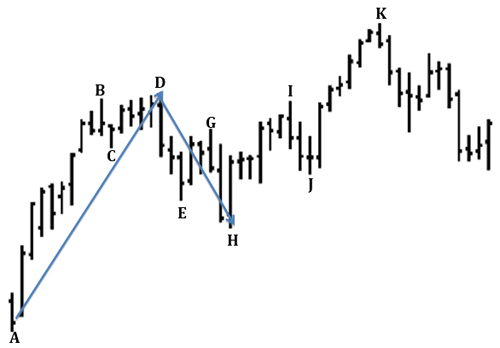
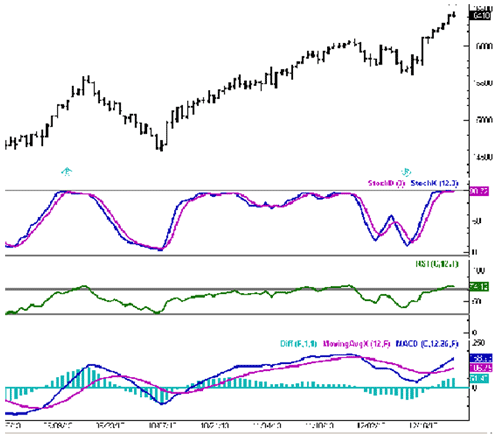
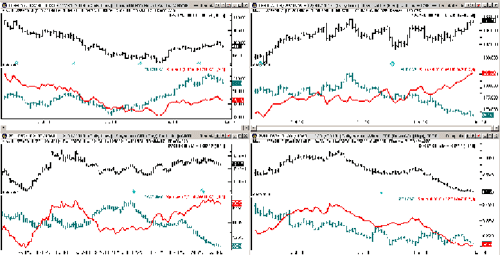
REVERSE ROSS HOOK (RRH)
Joe Ross (Newsletter No. 511)
Have you ever written something you wish you had never written? I wish I had never used or written the name "Reverse Ross Hook". The reason is that probably 90% or more times, a Reverse Ross Hook is the same as the #2 point of a 1-2-3 formation in the direction opposite to the direction in which prices were moving. With the RRH, something else is needed to indicate whether or not momentum is actually changing direction. For this purpose we can use a momentum indicator. In the case above I used a 5,3,3 Stochastic indicator. What we want to see is %K (blue line) crossing %K at the time we may want to set up a trade. The trade is this case would be to take a Traders Trick Entry ahead of a violation of the #2 point. Note: a #3 point has yet to form.Notice the vertical dashed line. As you can see, %K is still pointing upward with no hint of crossing %D to the downside, telling you that momentum is still upward, and to avoid going short.There are some finer details to this situation, which are explained in our seminar "Trading with More Special Setups." You can also learn how to trade Reverse Hooks in my hard-cover book Trading the Ross Hook.
Yours,
Joe Ross
WORKING YOUR BRAIN "MUSCLE"
Joe Ross (Newsletter No. 511)
A couple of years ago I read an article on "thedailybeast.com", which discussed the debate of whether or not the brain acts like a muscle. An interesting part of the article described a program that was set up for a low-performing elementary school in Oakland. Over the course of eight weeks, twice a week, kids would go into one of two rooms to play board games, video games, and card games. Each room had a particular function: one was to challenge kids' reasoning ability, and the other to challenge their processing speed.At the end of the program, the results were incredible. The group that trained for reasoning ability saw their non-verbal intelligence scores leap 32%, while the group that trained for processing speed saw their brain speed scores jump 27%. In just a total of 20 hours, the games had had a drastic impact on the kids' IQs.It would seem that these sorts of game activities are just what today's generation could use. We now live in a distracting, tech-enabled society, in which many cognitive skills are massively undeveloped. Texting, tweeting, etc., are very much in vogue, but aren't making our younger folks any smarter. In fact, one could argue these methods of communication are counter-productive in children's development, as many young people these days can barely carry on a real-life conversation.The easiest way to build up one's brain muscle is by reading. I am an advocate for reading as much as one can about the issues that are important to us, especially as we get older. Whether you're trying to better yourself financially, professionally, or improve your health, reading up on these topics is no doubt the best way to fill the information void. It's easy to kick back to watch movie after movie, or browse the latest celebrity gossip, but if you don't take the time to read thought-provoking material, your brain will certainly begin to atrophy. At some point, my guess is that your wallet will soon follow suit! Be sure to read about trading and investing. Do it often, and while you're at it, decide to agree or disagree with what you read!
Yours,
Joe Ross
TAKING THE PLUNGE
Joe Ross (Newsletter No. 513)
The experienced private trader doesn't have to trade all day, every day. Market conditions change, and it is wise to stand aside until your trading methods, your risk tolerance, and your objectives match market conditions.At other times you might be feeling "off," and it might be better to watch the market than to trade it. Trading is a matter of moving from studying and observing to actively participating. For the novice trader, or the trader in a severe slump, jumping in can be scary. Trading outcomes aren't a certainty. If you knew you could just put on a trade to take home a sure profit, you couldn't wait to put on trade after trade. (Actually, this is why most amateur online traders overtrade. They are unrealistically optimistic and put on a trade even if it has a poor chance of making a profit).The trading industry is loaded with half-truths with regard to losing. Let's take a look at what is commonly taught:"Getting actively involved in trading requires resolute implementation of a combination of cognitive and behavioral strategies."Now wasn't that a mouthful? I read it somewhere, and wrote it down so I could use it some day to impress you. Let's continue, because these wise words come from the talking heads of the industry, many, if not most, of whom are failed traders."On the cognitive side, you have to examine your thinking strategies and change them. If you are hesitant about putting on trades, it's because you are afraid. You're afraid to lose, to be wrong, and to face your limitations, etc."However, if you arm yourself with thinking strategies, you'll be able to put together enough courage to take the trade."Should you follow the sage advice of the trading industry?"Expect to lose! Winning traders take losses in stride, and that's what you are going to have to do."I don't agree with the assumption that you should expect to lose, especially if you have devised a strategy that makes losing a rare event. I have done that with my Money Master Strategies. However, let's continue with the wisdom of the industry. What follows contains some half-truths:"Look at your assumptions and change the internal dialog you have while getting ready to trade. You may think, 'If I lose, it will mean I can't trade.'True."But what you should think is, 'A loss is just feedback. It doesn't mean anything about me. I can still learn how to trade. I'm not going to set my expectations unrealistically high. I'm just going to see what happens, and no matter what happens, I'm not going to draw the conclusion that I'll never become an experienced trader. Even if I blow out my account, it will be a learning experience. It will be money I spent on tuition to learn how to master the game.'"There is some truth to the above. You will find it in the first two sentences. The rest is hogwash."Once you are armed with these cognitive strategies, you can face potential losses more easily. Some traders have even found it helpful to write down an upbeat passage, like the one above, and read it over and over before a trade and after a loss to restore a courageous, optimistic outlook." That is pure, unadulterated nonsense. "On the behavioral side of things, it's vital for survival to control risk. Make small trades and wait for high probability setups. There's no such thing as a guaranteed trade. Unless you manage risk, you'll surely blow out (especially if you are a novice trader), so you must risk relatively little on a single trade or set of trades." True."That said, you must bite your lip and take the plunge. If you are afraid to take the plunge, you might consider easing into it. Start out making extremely small practice trades. The trades can be so small that the commissions on them are more than any possible profit you can make. It's worth the costs. It will get your feet wet. It will take the mystery out of the whole process. People have a natural inclination to believe that a feared or dreaded event is more hurtful than it actually is. We tend to exaggerate the potential harm. Once we jump into the activity, however, we see that it isn't so bad. Our worst fears are usually never realized. Once you make a series of small trades successfully, you can increase your position size until you reach a position size consistent with your account size. The trick is to take gradual steps. It's like building up physical stamina. Don't try to do too much all at once. Work up to it." True, this is certainly an acceptable way to start out or even for testing a new strategy by an experienced trader. "Taking the plunge into trading actively can be scary, but we often think it's easier to avoid fears than to face them head on. If you examine the assumptions underlying your fear of losses, and then make actual trades to break out of your imposed psychological shell, you can master the markets and become a seasoned, winning trader." This sometimes works, but not for everyone. Some people are not cut out to be traders. There are simply too many hang-ups that can derive from events happening even before birth.
Yours,
Joe Ross
ANTICIPATING BREAKOUT DIRECTION
Joe Ross (Newsletter No. 512)
Is it possible to anticipate the direction of a breakout from an area of consolidation - in this case a rather sloppy-looking congestion? Notice that shortly after prices began to move sideways, at the end of the trend there was a 1-2-3 formation. However, prices failed to violate the #2 point. Instead, they moved into a tight consolidation containing too many price bars to be considered a ledge (10 bars). Within the congested area, a second 1-2-3 formed. This was followed by a Ross hook (Rh).In anticipation of a breakout to the upside, a buy stop could have been placed as shown. However, notice that I labeled that potential "buy" as "don't buy." In recent years, we have done a lot of work on refining the Traders Trick Entry. These refinements are being taught in our online seminar "Traders Trick -- Advanced Concepts."The second 1-2-3 formation defined a trend. The Rh established the trend. A few days later, a second Ross hook formed. A trader could consider placing a buy stop as shown just above the Friday's high. A buy stop there would be an appropriate entry for a Traders Trick.
Yours,
Joe Ross
"Nearly all men can stand adversity, but if you want to test a man's character, let him trade."
-- Old Trader
SOCIALLY RESPONSIBLE TRADING
Joe Ross (Newsletter No. 512)
Of all the email I receive, I dread most the ones that are sent to me by traders and investors who want to be (and want me to be) socially responsible. "Socially responsible" is cousin to being "politically correct." However, I am not a good judge of what is socially correct. I can measure moral correctness only in terms of the Bible. I have held Philip Morris, Altria, and Lorillard stocks at one time or another, and am looking to get back in. I own Kellogg's (the great adulterator of breakfast cereal), Kraft Foods (the purveyor of adulterated cheese), Coca Cola and Mac Donald's (the poisoners of our youth). Really, what can you invest in that is socially responsible? It seems that everything mankind touches is polluted or pollutes something else. Even the passing of gas by animals is said to contribute to global warming and pollution of the air!However, in the spirit of fairness, I want to "clear" the air by giving Ms. Amy Domini a chance to reveal her socially responsible thoughts to us. If you want to engage in socially responsible investing, you should look into the $1.5 billion Domini Equity fund, one of the oldest mutual funds based on social responsibility.It's all yours, Ms. Domini:"What is a social responsible company? I believe that many corporations operate under the assumption that profits are the first and only priority; many corporate leaders believe they should make money at any cost, but adhering to this standard has social consequences. I would argue that the company's 'fiduciary responsibility' will consist of meeting that standard, and they will feel justified to do that by any means. They may feel it is moral to bribe somebody at the accounting standards board to create new accounting standards that may make the company look more profitable. Under that standard, it will be their moral obligation to cheat, bribe, and steal. They will feel it is moral to do whatever they can to make money, regardless of the social costs.'""What role can investors play? The way you invest builds the world your children and grandchildren will grow up in. You must ask, 'What kind of world do you want them to grow up in?' There are two issues to consider: universal human dignity and ecological sustainability. One should be comfortable as a human being; you would like to avoid needing an armed guard every time you left home or requiring your children to play behind a barbed wire fence. There's also a health aspect as far as the planet goes. It's pretty simple and straightforward, but right now, the corporate culture works against these issues because the standard is to make a profit at all costs, and human dignity costs money. Environmental responsibility costs money.""There are advantages to investing in socially responsible companies, in addition to the fact that they address issues of human dignity and ecological sustainability. It's harder to both turn a profit and remain socially responsible. Innovative executives usually run companies that address social and ecological issues. They are on the ball and proactive. And because socially responsible companies are more innovative, they tend to be more profitable over the long run."It's possible for companies to be both profitable and socially responsible. One wants to be mindful of the world you want your children to grow up in. One wants to be mindful when investing. The investor has ultimate power. The investor is over weighted in power. He or she has more power than other players at the table and needs to take responsibility for his or her actions."Thank you for your thoughts Ms. Domini. You have convinced me. Turn on the wind generators, and let's kill more birds. Let's not eat any more beans because they cause flatulence. We already have enough flatulence from the hordes of cows, sheep, and pigs. Don't trade corn futures because they are used to make ethanol, which destroys your car engine. Let's make more solar panels...uh...wait a minute, I read somewhere that the manufacture of solar panels creates more pollution than it saves.Forgive me, please! I have 3 solar arrays on my roof.
Yours,
Joe Ross
LONG CLUSTER BREAKOUT
Joe Ross (Newsletter No. 514)
Before starting to seriously trend down, the Canadian dollar (C$) had been very strong, holding its own against the U.S. dollar. It had definitely stayed close to parity with the U.S. currency. The Canadian economy was in relatively good shape. The nice part of the C$ downtrend is that there was a Long Cluster breakout available on the daily chart. It would seem that C$ is headed for 90 cents in the not-too-distant future, maybe even by the time you get this issue of Chart Scan.On the chart above we see the Law of Charts at work. First there is a fairly level long cluster ahead of the downside breakout. But, was there a way to tell which way prices would actually break out?Notice the 1-2-3 low made during the period of price consolidation. Next, look at how prices failed to violate the #2 point, and, in fact, reversed direction at the arrow. This demonstrated significant weakness in the C$.Please notice where I drew the "support" line on the chart. Although prices dipped below that line, they never closed below that line until the breakout. The overall lower highs contributed to a downside expectation. Finally, prices broke decisively below the support line. The Long Cluster breakout and how to trade it are discussed in my book Day Trading, and at my 2-day day trading seminar. It is part of the Law of Charts.
Yours,
Joe Ross
THE ART OF KNOWING
Joe Ross (Newsletter No. 514)
If you're an eternal optimist, you hate bad news. But bad news is relative. What is bad news to some people is mere information, and possibly good news, to others.Some traders hate bad news, and do anything to avoid hearing it. It takes many forms, and at Trading Educators we have heard them all.Some traders keep losses on paper to avoid acknowledging them. Other traders avoid looking at performance statistics, such as a win-loss ratio, in order to keep up the illusion that they are making huge profits. Others fudge a little, making a bunch of low profit trades to artificially boost their win-loss ratio, and still others feed their accounts every month with the hope that someday they'll make the huge profits they've been hoping for.In the end, these are all just ways of using psychological "denial;" futile attempts to passively solve problems instead of taking active, decisive steps to solve them. But knowledge is power, and the more you know about your trading performance, the more you will be able to improve your trading potential to take home more profits.Denial can be useful at times. For example, if you have developed a thorough trading plan with very little that can go against it, it doesn't make sense to focus on the few unlikely events that may ruin your plan.If you focus on what can go wrong, you'll hesitate. You may unnecessarily question your plan. At the moment you are ready to execute your trade, a little denial helps matters. You feel carefree and ready to see what will happen next. However, over the long term, denial does more harm than good.If you are trying to avoid monitoring your trading performance, you will always feel uneasy. You will secretly dread taking an honest look because you are afraid of what you'll find.It's hard to look at our performance when we think things aren't going well. But if we don't, we cannot find ways to improve. It's all a matter of attitude.Winning traders carefully look at their performance. They view it as a process that may need fixing. Just as an auto mechanic tries to fix a broken car, the winning trader identifies what works and what doesn't.Rather than passively ignoring the problem, winning traders actively identify what's going wrong and make changes. They stay detached and look at their performance objectively, as if they were merely watching a television documentary.If you haven't looked closely at your performance lately, think about doing it soon. Keep a positive attitude. Don't look at it as a dreaded event, but as an opportunity for improvement. Don't be afraid of what you may find. If you don't meet your expectations, don't look at it as a failure. Just look at it as a type of objective feedback that you can use to improve your trading approach.Stay calm and upbeat. If you look hard enough and think about it enough, you'll find creative ways to trade more profitably. And if you don't immediately find new solutions, it is much better to stand aside until you do, rather than to keep losing money on strategies that just don't work. If you take an active problem-solving approach to finding ways to improve your performance, you'll eventually achieve profitability, and if you keep looking, studying, and changing, you'll stay profitable across a variety of market conditions.
Yours,
Joe Ross
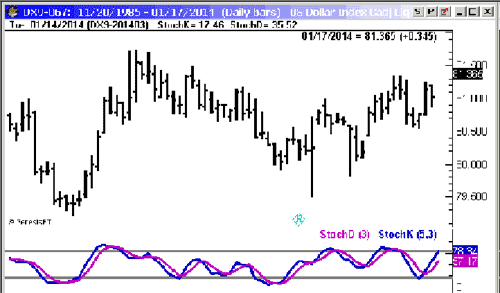
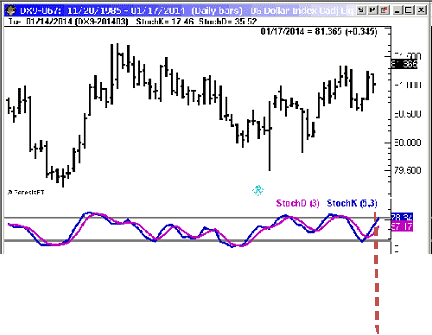


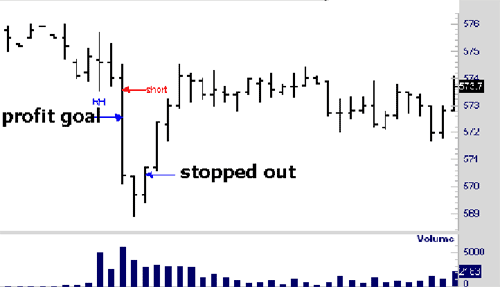
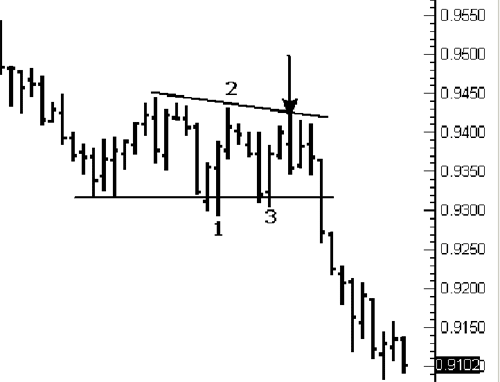
LINE CHARTS
Joe Ross (Newsletter No. 515)
Someone sent me an email asking if the Law of Charts can be used with line charts. I started to give him my standard answer -- "a chart is a chart, is a chart," but then I thought I'd take the opportunity to write a bit more about line charts. Except for a few spread bar charts, most spread charts are line charts. The reason for that is because the only thing that really matters with spreads is where they close. When you connect closes, you get a line chart. Believe it or not, to this day the chart most used to depict many kinds or studies or statistics are line charts -- that includes price charts for stocks and bonds. Line charts are still the charts most used worldwide.The chart above shows how I mark a line chart to reveal The Law of Charts formations.
Yours,
Joe Ross
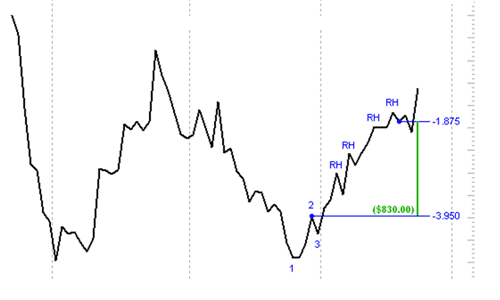
ACCEPTING AND REDUCING RISK
Joe Ross (Newsletter No. 515)
Trading is risky. Depending on your personality, you may be extremely intolerant of risk. I know a man who uses "risk-averse" for his email address. Most people avoid risks at all costs. Humans had to make prudent decisions in order to survive and evolve. Even though traders know they must risk money to make money, the natural inclination to avoid risk is powerful. How much risk are you willing to take? There's no right answer. It depends on you. If you are a risk seeker, you may not mind risk. You may actually embrace risk and uncertainty. But if you're like most people, the more risk you can eliminate, the better. You used to be able to avoid risk entirely by putting your money into a savings account. However, those days are long gone, and such an investment would bring relatively little profit. The lure of short-term trading is that you have the potential to make huge profits. The downside is the uncertainty and risk you must accept. However, the amount of risk you take is still up to you. For example, for most, but not all traders, it is more risky to trade markets with excess volatility or very little liquidity, so avoiding them will help you stay calm if you have low risk tolerance. Traditional approaches to risk control can also help, such as having a diverse portfolio. If you trade various markets that have little correlation, you have some insurance that a drop in one market may not automatically coincide with a drop in other markets. But no matter how much you try to avoid it, you must decide how much risk you are willing to take. Perhaps the most unnerving aspect of risk in the markets is the fact that it is impossible to know all possible risks up front. Who knows what will happen? There are many events that you just can't control. For example, a media analyst may talk up or talk down a market you're trading, and it may thwart your trading plan. An unexpected national event may influence the markets in ways that you hadn't anticipated. And when it comes to selling off a position, you might not get the price you want at the moment you're trying to sell. And then there are more basic problems that hamper your plans, like a computer crash or an Internet connection line going down. In the end, you must psychologically accept the fact that there are some risks that you can't control. You may not be able to completely avoid all possible risks, but you can take steps to reduce risk. For example, by setting a stop loss you can, within limits, determine how much loss you are willing to take. It may take some skill to know where to place the stop loss so you won't get prematurely "stopped out," but in principle you can reduce your risk by deciding a point at which a loss is great enough that you would rather close the trade than continue. You can also reduce risk by avoiding thinly traded markets. Even the most brilliant trading plan will fail if there aren't enough buyers and sellers to make it work.Reducing risk can be a matter of choosing the right stock market: if you are especially risk-averse, you can stand aside until there is a strong bull market. But whatever you decide to do, always remember that you have choices. You can decide how much risk you want to take. By matching the amount of risk you take with your tolerance for risk, you can trade more calmly, and that usually means you'll trade more profitably.
Yours,
Joe Ross
POINT AND FIGURE
Joe Ross (Newsletter No. 516)
Last week I showed that line charts follow The Law of Charts just as do bar charts or candlestick charts. The same is true of Point and Figure charts. Take a look at the chart on the left. One of the best traders in the world today is my friend Braam Avenant. Braam showed me that he uses TLOC to trade Point and Figure charts. Until he showed me, it never entered my mind that there was such a possibility. There are still many stock market traders who use Point and Figure charts.Notice the columns marked TTE (Traders Trick Entry). These are slightly different from the way they appear on bar or candlestick charts. You do not attempt a long entry until the green Xs breakout from the brown Os. The opposite is true for downside TTE breakouts.
Yours,
Joe Ross
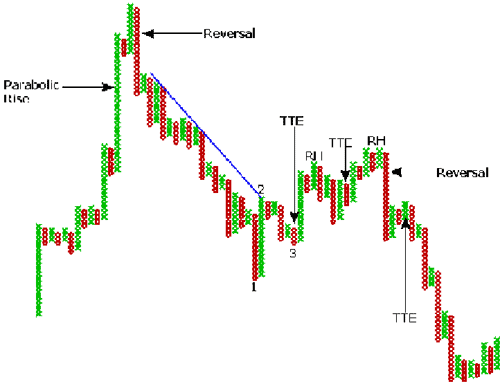
WHEN IS A TREND A TREND?
Joe Ross (Newsletter No. 517)
One of my students sent me the following chart. We are looking at a 4-minute chart of gold futures, and the move down was identified as a trend. But was it a trend? The answer is arguable: as is often the case, the answer is in the eye of the beholder. Certainly we see a move down consisting of lower highs and lower lows, which is the most basic definition of a trend.Personally, I see an explosion followed by a collapse, a chart situation you often see when some kind of report comes out. It 's a big deal on a 4-minute chart, but only a blip on a daily chart.There was another question associated with this chart: "Is it tradable?" "Can I go short?"Let 's face it, any chart is tradable, but why trade this one? Surely, with all the available markets and time frames, something better; something easier to trade could be found.Why do traders want to marry a market or a time frame when there are so many great trading opportunities available? Is some kind of sick sense of loyalty involved? For me, if I were married to this market, one look at it would be grounds for a trial separation!
Yours,
Joe Ross
THE HUMBLE TRADER IS THE WINNING TRADER
Joe Ross (Newsletter No. 516)
Trading can be frustrating at times. You put in a heroic effort, but it doesn't always pay off in the way that you had hoped. When you finally do win big, you naturally want to celebrate. You may even get a "swelled head," and feel invincible, as if you are on top of the world. Why not celebrate? You deserve it.It's healthy to occasionally pat yourself on the back for a job well done, but don't get too "full of yourself". There are many tales of expert, skilled traders who were at the top of their field and the idol of many, but due to changes in the markets, ended up busted. Just when everything seemed to be going well, market conditions changed, and methods that once brought in steady profits suddenly stop working. That's why experienced traders suggest staying humble. You have to stay humble and focused on continually sharpening your trading skills in anticipation of the next major change in the markets. A humble approach to trading will help you to stay calm and focused.Getting a swelled head often interferes with maintaining a calm, objective, and unemotional mindset. Basking in the glory of success can be intoxicating. You may start to think you are invincible, as if you can't lose. You may then start bragging to your friends about how well you're doing, or start spending money extravagantly. When that happens, it may be the start of your demise. In a subtle way, you will start to put extra pressure on yourself to perform up to especially high standards that are almost impossible to maintain. You'll try to keep up your reputation. You may dread a failure because should you fail, you will have to admit to yourself and friends that you were not as invincible as you had claimed. At that point, you may have trouble being objective. And once that happens, it's bound to impact your trading. The added pressure to perform, along with the psychological need to save face, will take a toll on your limited psychological and emotional resources. You'll have less energy to focus on your trading, and you will likely make trading mistakes that will lead to your downfall.It's important to keep your ego out of trading. Don't build yourself up, but don't overly criticize or condemn yourself either. Stay realistically upbeat and focus on developing your skills as a trader. Work towards excellence, not perfection. You have to be good, but not perfect. You must have top-notch trading skills, but you don't need to be the best trader in history. When you take your ego out of the picture and stay modest, you'll find it easier to concentrate. And when you focus on the process of trading, rather than on the prize, you'll trade more profitably.
Yours,
Joe Ross
IN A TRADING STATE OF MIND
Joe Ross (Newsletter No. 517)
If you're like most people, your moods change throughout the day. There are times when you are extremely energetic and optimistic. You feel as if you can do anything. You're in an optimal state of mind for trading. A "state of mind" consists of a set of moods, feelings, thoughts, and memories. In an optimistic state of mind, you feel powerful and ready for action; you feel enthusiastic and energized. You have a can-do attitude. You remember past triumphs and you're inspired as you think of your past accomplishments. You are open to new ideas, and you can creatively think of new trading strategies. You are eager to trade. At other times, though, you may feel "down in the dumps" and beaten, as if you are paralyzed by your emotions. You remember every failure, no matter how small, and you wrongly believe that these minor setbacks illustrate your inadequacy. As you might imagine, some states of mind are more conducive to trading than others. Sometimes your moods, and corresponding states of mind, change for no apparent reason; it may just be the time of day or a biological mechanism. At other times, your moods reflect daily events such as a string of unexpected losing trades. But regardless of how it happens, your current state of mind impacts how you approach trading. When you are ready to execute a trade based on your meticulously defined trading plan, and you are also in an optimistic state of mind, you execute your plan flawlessly. By contrast, at other times, your states of mind are less than optimal. For instance, you may feel pessimistic when you are ready to execute a viable trading plan, and if you allow these feelings to dictate your actions, you may decide to abandon the plan for no good reason. It would be nice if you were always in an optimal state of mind, but it isn't always the case. You may be a trader who is naturally tired during the trading day, but in the evenings, after a little rest, you think clearly and creatively. In that case, you may find it useful to devise specific trading plans off hours when you are in a creative, optimistic mindset. When you go to execute the plan the next day, though, you may feel dreary and unenthusiastic. However, if you have a well-defined plan that is clear and easy to follow, you find you can ignore your current feelings, and focus all your energy on executing the plan. You may think, "I'm not going to let my low energy mood interfere. I can't think clearly when I'm like this, so I'm going to just focus on execution and live with what happens. As long as I follow my plan, I will have met my objective." Be careful if you are a trader who may be overly optimistic during the trading day. Extreme optimism can be dangerous. Overly optimistic traders may feel invincible, and get a swelled head. You may impulsively put on low-probability trades, seeing positive signs when there aren't any. Later in the day, you may think, "How could I have been so impulsive?" During more calm and rational moments, you may see things more clearly. At these times, you would be wise to use these states of mind to clearly map out trading plans. Once the trades are mapped out and clearly specified, the trading plans can be more easily executed when market conditions are just right. Because your moods may not be optimal at the moment of execution, a detailed trading plan can ensure that a trade is executed with discipline. Whether you are overly optimistic, dreary and pessimistic, fearful and anxious, or frustrated and scattered, if you have a well-defined trading plan, you can temporarily ignore your current state of mind and focus all your available energy on executing the plan. A less-than-optimal state of mind doesn't have to hamper your trading. You can still trade profitably if you make a detailed plan and trade it.
Yours,
Joe Ross
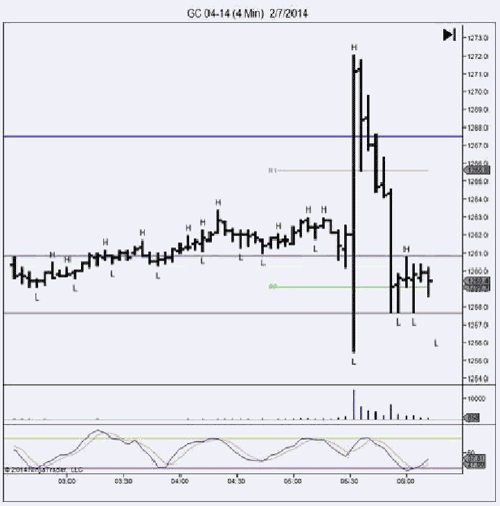
REVERSAL BARS
Joe Ross (Newsletter No. 518)
Would you go short based upon the last bar of the chart below? I would, and I'll tell you why:
-Based on Bollinger Bands [setting 18 bar moving average and 2 Standard Deviations], prices sharply reversed when prices far exceeded 2 Standard Deviations from the moving average.
-Not only did prices sharply reverse, but they finished near the low of the bar. I would be looking for some sort of follow-through for, at the very least, a short-term scalp trade.
-The Stochastics indicator is showing a reversal in momentum. Note: This particular setup, and how to use Stochastics in conjunction with Bollinger bands and reversal bars is taught at my "Trading with More Special Setups" online seminar.
Yours,
Joe Ross
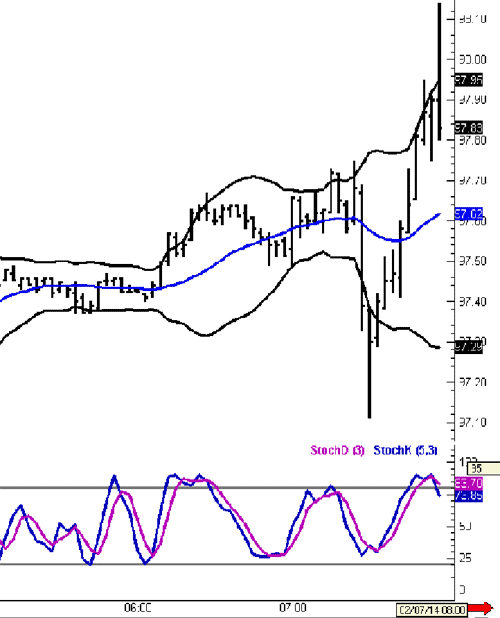
THE COMPLEX EMOTIONS OF LOSS
Joe Ross (Newsletter No. 518)
Losses apply to all traders, regardless of their chosen markets. The story below could apply to Forex, futures, bonds, or stocks.Ray Activ has just taken a big risk and lost. He has been watching a stock for the past month and it's been going down. But today an earnings report was released. Yesterday, Ray had a strong hunch that actual earnings were going to beat analysts' estimates. In preparation for the possible price move, he bought 1,000 shares, expecting it to go up substantially after the earnings announcement. He was so sure that the stock was going to move in his favor that he didn't use a stop-loss. Unfortunately, when the actual earnings were reported, it missed analysts' expectations by quite a bit, and the crowd was watching. The price fell hard and fast.Ray lost a large portion of his account, and he is understandably upset. He blames fate, and he blames himself. He is now experiencing a variety of intense emotions. Ray is reacting with anger, guilt, fear, and disbelief. This mix of emotions is complex, but unless Ray learns to cope with them and move on, his financial loss may also have long-term emotional consequences.Ray blames fate and himself. He asks, "Why couldn't events go my way? I should have been more skeptical. I shouldn't have trusted my intuition. I shouldn't have risked so much. I should have used a stop-loss." Ray's reasoning makes some sense. He feels disappointed for trusting himself and angry at external events for not going his way. He feels guilty for losing, as if he has let himself down. He wonders what he could have done to prevent the losing trade. He tries to pretend that it just didn't happen. He thinks, "Maybe I could have risked less or prepared for the trade more. I should have studied every possible factor that was driving the price down, and accounted for them in my plan." Ray's feelings are a natural response to the loss. The internal dialog that underlies his emotions is also understandable. He wants to undo this event that he views as devastating and humiliating.How should Ray cope with these emotions? First, he needs to stand back and look at things logically. Right now, his emotions are getting the better of him. Some positive self-talk would work well right now. Sure, he risked more than he should have, but that doesn't make him a bad person, and it wasn't necessarily a bad idea to do what he did. There are times when traders abandon their risk limits, so taking on extra risk in and of itself isn't a bad thing. Perhaps Ray should have thought of other factors that might influence the price, or considered these factors when developing his rationale for believing that earnings would beat analysts' forecasts. If he had objectively looked at the evidence rather than go with an unfounded hunch, he might have fared better. However, seasoned traders often go with hunches, so doing so isn't inappropriate.In addition, information isn't always accurate, so even if he had studied all the available information more closely, he might not have been able to anticipate what would happen with complete certainty. In the end, Ray should ease up. He tried his best, showed courage by putting on a risky trade, and should pat himself on the back for his efforts. He may have made a few mistakes, but he is only human.Second, he needs to decide what he has learned from the experience and do things differently next time. What should he learn? It depends on his experience. There isn't just one right way to trade. For Ray, he might decide to never again fully trust an unsubstantiated hunch, to avoid risking more than he should considering the size of his account, or to consider the advantages of using a stop-loss. Other traders might draw the opposite conclusions, depending on their market experience. He could accept that hunches are right most of the time, but wrong at others. He could decide that risk and loss are commonplace in trading and that he shouldn't get very upset about them. And he may decide that there is absolutely nothing he could have done, and hope for the best next time. In the end, he has to decide for himself what, if anything, there is to learn. It is entirely his call. The main point is that, when facing a loss, traders need to do two important things: avoid extreme emotions through monitoring and changing self-talk, and to quickly decide what lessons, if any, are to be learned from the experience - then just move on.When facing a loss, it's hard to not become consumed with guilt and anxiety. But these emotions usually get you unnecessarily upset. Rather than focusing on the next trade, you end up mulling over something that you couldn't have changed. It's often better to take losses in stride, and move on.
Yours,
Joe Ross
WHERE DID THE TREND BEGIN?
Joe Ross (Newsletter No. 519)
The chart to the left is taken from a much larger chart of the Indian Nifty-Fifty. Prices had been in an extended trading range leading up to the section shown above. The question is, "where did the trend begin?"
There are many ways to define trend, and recently I mentioned one of them: if prices overall are making higher highs and higher lows, prices are trending up. However, on the chart, prices had been in an extended trading range long before the bar you see marked "1." One way we define trend at Trading Educators is that a violation of the 2- point of a 1-2-3 formation defines a trend, and a subsequent violation of a Ross Hook (RH) establishes a trend. We see an overall 1-2-3 formation, and by definition the #3 point was created when the 3rd bar following the #2 point made both a lower high and a lower low. However, there failed to be any follow-through, so it is with poetic license that I marked the broader formation as a 1-2-3 low. Please understand that I could have marked as #1 what you see marked as #3. In that case the first RH would be marked #2, and three bars later would be marked #3. So much of trading involves what you see. Looking at everything from the point marked "1," there is no question that prices were trending up.
Yours,
Joe Ross
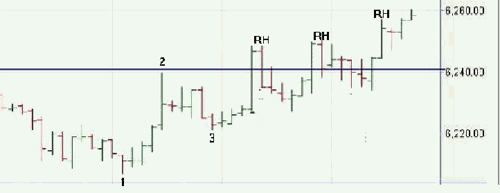
WHO YOU CALLING RICH?
Joe Ross (Newsletter No. 519)
Have you ever been a part of a conversation when someone decides to anoint a particular individual with the "rich" label? There's not really anything wrong with it, except for when the next part of the conversation moves on to discrediting how he/she was able to get in their particular position. Yes, sometimes people born into wealth squander their head start and "blow" their family's fortune. However, those folks are in the extreme minority. The vast majority of "rich" people I've known have accumulated wealth as a result of taking risks, working very hard, and spending and investing their money wisely over time. These factors are present no matter what avenue people travel down towards building wealth. Another mistake people often make when discussing "rich" people is assuming how "lucky" they are. Again, most people have built fortunes through hard work and sacrifice. Luck usually has very little to do with it. Finally, I urge you to be wary about how you discuss the wealthy around children. Young people are very impressionable, and the last thing you want to do is attach a negative stigma to those with money. Building wealth over the long term is not that difficult. Make sure your children or grandchildren understand that. Encourage them to dream big! I tend to excuse myself whenever a negative cloud begins to build about how or why someone is "financially fortunate." I exercise my mental muscles each day along my own path to wealth, so why sit among company who will only discredit my goals?
Yours,
Joe Ross
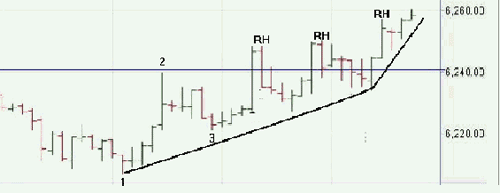
WHERE DID THE CONSOLIDATION BEGIN?
Joe Ross (Newsletter No. 520)
I submit that it began at the arrow. The way I determine where the trend ended and the consolidation began is to find the vertical center of the entire consolidation area. It is a bit subjective as to where to draw the upper and lower lines. I try to find places where prices touched, opened, or closed a few times.
I add the high of the consolidation to the low and divide by two. I draw a midline across the entire area, and look for the bar or candle furthest back that best represents the vertical center - a bar that best splits the midline. As far as I'm concerned, that bar or candle is where the trend ended and consolidation began.
Yours,
Joe Ross
I WILL NEVER STOP LEARNING
Joe Ross (Newsletter No. 520)
I will never stop learning. This is my mantra and I will continue to practice it each and every day. Why? Because you never know where your next big opportunity may lie.
Constantly learning will benefit you in many areas of your life. You'll uncover new investment opportunities, such as dividend stocks that are attractive for new money. Or, you can acquire new skills that open the door to bigger promotions in the workplace. You could even pick up enough expertise that you can then venture out on your own as an entrepreneur. As you continue to learn, you can routinely tweak your strategies to accommodate changing market conditions.
There are doors that remain ajar on every corner. One of those doors could lead to amazing experiences and could bear the fruit of a lifetime. I sometimes think of Ray Kroc, who took a small hamburger franchise named McDonald's (MCD) and turned it into a global empire. Mr. Kroc began his foray with McDonald's at the ripe old age of 59! Colonel Sanders did the same with Kentucky Fried Chicken. The Colonel was 65 when he got the ball rolling with his company. These men seized an opportunity and parlayed some initial success into massive fortunes - and didn't let their ages get in their way one bit.
So you see, it's never too late to get started building your own fortune. Many people will sadly pass away with fortunes only in their mind, never to be shared with the rest of us. Whether their barriers were financial, emotional, or just a form of laziness, most people will not fulfill their true potential.
Make a promise to yourself to never stop learning. Learn about what makes other people successful. The clock is ticking, but it's never too late!
Remember, the older people get, the less likely they are to seize opportunities that come their way. Be proactive, not reactive. Build up your skill-set now to secure a brighter tomorrow. Ask anyone who has been laid off after spending a lifetime in one job or at one company, and they'll tell you how devastating it is. Most of these people never developed any additional skills to fall back on.
When you're always learning, you're never fearful of the future. Even seemingly bad things like being laid off are met with nothing but excitement for those who've continually improved themselves. What new opportunities lie around that corner? The possibilities are endless.
Yours,
Joe Ross
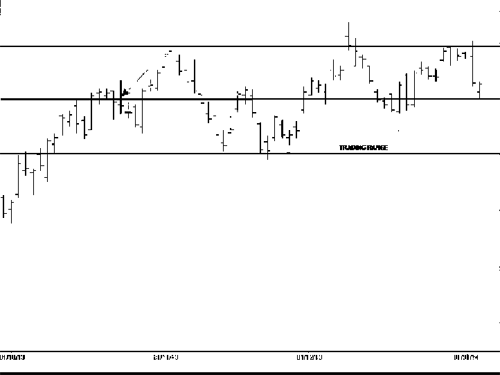
HOW NOT TO MANAGE
Joe Ross (Newsletter No. 521)
Howe Knott didn't have much money, and it bothered him a lot. Howe had lost his job, and was at home in his small apartment when a broker telephoned to persuade him to open an account. Howe listened as the broker convinced him he didn't need a lot of money to trade from a one-minute Mini Dow chart. The broker, Les Skinem, knowingly pontificated about trading the "YM." He said he would show Howe a simple setup that offered a high expectancy of being on the right side of most trades. By the time the conversation was over, Howe was building castles in the air. He could envision a new car, a nicer apartment, maybe even a speedboat. True to his word, Skinem, a failed trader-turned-broker, showed Howe how to setup a standard, 14,3,3 Stochastic indicator on a one-minute chart. Skinem told Howe that whenever %K first reached Stochastic value of 25 or less, and then crossed %D to the upside, Howe should buy, and whenever %K reached Stochastic value of 75 or greater, and then crossed %D to the downside, Howe should sell. Skinem brought up a YM price chart to show Howe how easy it was to use this method of trading.
Howe could hardly believe his eyes. Seven out of eight times prices moved the way that Skinem said they would. Howe thought they should rename this indicator from Stochastic to "Fantastic." There was one major problem with this incredible method, and the problem was one of management. Skinem told Howe about risk/reward ratios. He said you should risk $100 to make at least $200. He failed to reveal that not a single one of these trades would have made $200. Why? It's because there is frequently not enough movement on a one-minute YM chart to be able to make $100, let alone $200. Here are the sad statistics:
Trade #1: Sell. Had Howe sold at the very high of the move and bought back at the lowest low, he would have made $50. More than likely, Howe would not have bought back at the absolute low, and would have taken a loss. Prices moved against him, as you will see with Trade #2.
Trade #2: Buy: Assuming Howe had gotten out at the low of Trade #1, and immediately went long on trade #2, he could have made $105, provided he entered at the absolute low of Trade #1 and exited at the highest high possible.
Trade #3: If Howe had entered at the absolute high of Trade #2, and exited at the lowest possible low, he could have made $55.
Trade #4: If Howe went long at the absolute low of Trade #3, and exited at the highest possible high, he could have made $115.
Trade #5: If Howe went short at the absolute high of Trade #4 and exited at the absolute low, he could have made $35. However, before Trade #6 he would have been stopped out with a loss, or at best at breakeven.
Trade #6: From absolute high to absolute low prices moved $55. Of course, the signal to sell came on the bar after the absolute high, so the trade made even less.
Trade #7: From the absolute low of Trade #6 to the absolute high, prices moved $110
Trade #8: From the absolute high of Trade #7 to the absolute low, prices moved $55.
Never once could Howe have made any more than $115, much less $200. The truth is that unless Howe was a genius and had traded perfectly, entering short at the highest highs and entering long at the lowest lows, he would have lost on every trade in which he expected to risk $100 to make $200. He couldn't have made as much as $150 risking $100. I allowed those trades to make more than they would in reality, because not even once did the buy or sell signal come at the highest high, or lowest low. I constantly have contact with traders who want to trade the Mini Dow on a 1, 2, or 3 minute chart, and who have never figured out that there is not enough movement in that market in those time frames to be able to trade successfully. During the same time frame, using a 3-minute chart, there were 4 trades, all of which gave terrible signals. However, the moves on a 3-minute chart will normally be greater than those on a 1-minute chart. The 4 trades yielded $130, $115, $45, and $115. Don't think that because you have a small account that it means you have to trade a small time frame. If you are going to risk $100 to make $200, then you need to trade in a time frame that will enable you to see price moves of greater than $200. To make $200 on winning trades you need to see at least $250 of volatility, simply because you are not going to be able to enter at the absolute highs and lows of any move.
Yours,
Joe Ross
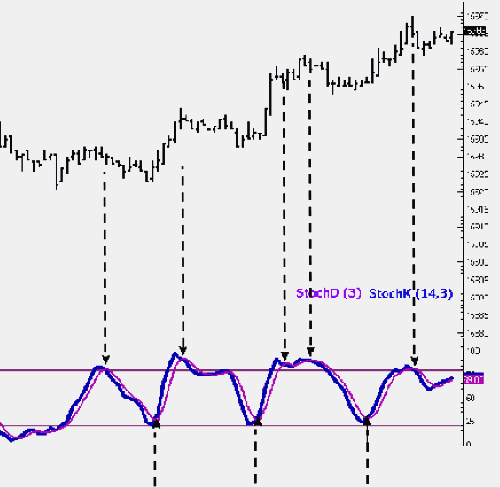
WHAT DID THE MARKET DO TODAY?
Joe Ross (Newsletter No. 521)
In a number of places and at various times, I've mentioned that trading in the past was a lot easier than it is today.
When it comes to making money over the long-term, the "instant results" generation is at a huge disadvantage. Most of the focus today (thanks to the business media) is on checking your financial scoreboard frequently. As a result, many modern market watchers are more like gamblers than patient traders and real investors. It's reached the point where most people will simply ask "What did the market do today?" to get a gauge on how markets are performing.
If you're a trader, you can know almost immediately how you are doing. If you are an investor, it's also easier than ever to access your brokerage account and check the status of your holdings. Market participants these days have the benefit of smartphones, tablets, laptops, and more - all while "on the go."
We can't fight the trend of mobile access, but we should certainly pace ourselves. Realize the seeds we plant (in the form of long-term trades) do not need constant (hourly) monitoring. Instead, our trades are best left to accomplish their objectives without too much maintenance.
I suggest long-term traders make it a daily, or even weekly, habit to check on their trades. That way, you can stay on top of things without worrying about the false idol of overnight results.
Do you realize that it wasn't too long ago, that about the best you could do was to see the status of your trades in a daily newspaper? People made money then, and money can still be made that way, without the frantic interference, chaos, and confusion of intraday charts.
Yours,
Joe Ross
EURO FX
Joe Ross (Newsletter No. 522)
Euro FX and Euro/Dollar are as close to identical twins as it is possible to get. If you look at their charts side by side, or one below and the other above, you will see what I mean. So anything I say here about Euro FX applies equally to Euro/Dollar.
As you can see on the chart below, Euro FX made a 1-2-3 low. On the bar marked "3" there was a Traders Trick entry to go long 1 tick above the high. I marked that "Entry 1."
Prices shot up and then corrected, giving the first Ross hook(TM) (RH) of the day. Entry 2 from the Traders Trick along with good trade management offered an opportunity for a small win, but more than likely a breakeven trade.
A couple of bars later another RH formed and provided a second Traders Trick entry. This time prices moved up nicely, and good profit was available. I labeled that one Entry 3.
Finally, you see Entry 4, which took place just ahead of exhaustion. The Close of the highest bar shows that momentum was no longer there. Still, the worst anyone should have done with that trade was to break even. There were enough ticks to ensure that result.
The Traders Trick, along with the law of charts, continues to provide opportunities for traders willing to learn to use them. Keep your eyes on the charts: they are the source of the best trades.
Yours,
Joe Ross
OVERCONFIDENCE
Joe Ross (Newsletter No. 522)
When traders are hot and seemingly cannot lose, when they make several trades that perform exceedingly well, there is a surge of human pride. They feel like the pitcher who strikes out the other side for all nine innings of baseball! They feel invincible, brilliant, and like master traders, to say the least. When a trader feels like that, he thinks he can do no wrong and make no mistakes. He comes to believe and even say to himself: "Risk - I can handle it! I make such insightful decisions I'm not even worried about risk."
The brilliant trader feels he is invulnerable. The truth is that at that very moment, the trader is extremely vulnerable. He could be headed for a fall. He forgets that most performances eventually revert to the average. If you chart the equity in your trading account, and it shows your equity going up parabolically - look out below!
Yours,
Joe Ross
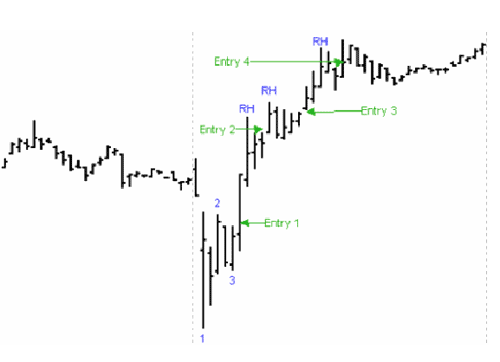
END OF A TREND?
Joe Ross (Newsletter No. 523)
Someone sent in a question asking: "Do you think we are looking at a 1-2-3 low at the end of a trend?"
In order to obtain an answer, we have to be able to tell the difference between a trend and a consolidation area. So, let's look at that chart in a slightly different way:
A 1-2 formation leading to a possible 1-2-3 low formation has no meaning when it is inside a consolidation area. Consolidations often have 1-2-3 formations in both directions, i.e., 1-2-3 highs and 1-2-3 lows. What is needed before consideration can be given for entry, is a 1-2-3 formation followed by a Ross hook. A Traders Trick Entry could be considered at that time.
Yours,
Joe Ross
REPETITIVE MISTAKES
Joe Ross (Newsletter No. 523)
Anyone is allowed to make one mistake. When the same mistake is repeated a second time, caution should be noted. The third repetition of the same mistake constitutes self-destructive habitual behavior that must be reversed! All trading must stop immediately until the trader's self-discipline is thoroughly examined. Once the reason for the repetitive mistakes is understood (usually fear, anger, or guilt) it must be corrected before trading may begin again. Some traders lose money because they are atoning for guilt feelings or gifts they feel are undeserved. Such traders should donate funds to their favorite charities, not to other traders!
Any flaw in a trader's character, such as greed, hatred, dishonesty, revenge, arrogance, etc., will soon result in a loss of money. Traders must know the markets as well as they know themselves. Negative feelings towards any person, or one's self, must be replaced with the understanding that these feelings are choices the trader has made that will eventually cause personal and financial destruction. Negative feelings prevent the trader from realizing his maximum growth potential, because his choices for growth have been limited by his self-defeating thoughts. The mind's electrochemical network sends energy impulses throughout each atom of the body as it thinks. Thoughts create feelings experienced by the trader. Traders should take trades based on scientific price action analysis, not on feelings. Deschapelles, the French chess champion, would give his opponent a pawn before the game began. This action always provided the necessary excuse for losing. Give nothing away when trading markets; enough will be taken from you.
Yours,
Joe Ross
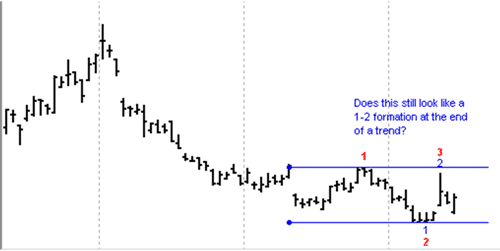
SPREADS
Joe Ross (Newsletter No. 524)
Whenever I sit down to write an issue of Chart Scan, I am always reminded of how many great spread trades are being missed by those who throw their money at the markets by day trading the wrong contracts, in the wrong markets, at the wrong time of day, and who think that trading entails sitting behind a screen all day. My friends, sitting there all day, sometimes making a little and often giving it all back, is work, not trading. You become a trader in order to NOT have a job. You become a trader to obtain the things in life you always wanted. If this paragraph describes you, perhaps what you need is additional education in how and when and where to trade! The spread we are looking at is long soybeans and short soy meal from late January until early March. During the time the spread was in force (red line), $7,476 was available (green line-green numbers).
The reason for the sharp move up was simply because soybeans were moving up faster and more steeply than was soy meal: soy meal is a bi-product of soybeans. I believe that you are going to see this trend continue for many months into the future due to the El Niño that is brewing off the coast of Peru as I write this issue (April 25, 2014). Long soybeans will be the place to be in all of 2014 and into all of 2015. Expect worldwide food shortages because of El Niño.
Spread trading, as with soybeans and soy meal, may very well be the most profitable, yet safest way to trade futures. It offers many advantages which make it the perfect trading instrument for beginners and traders with small accounts (less than $20,000) as well as for professional traders who use spreads to optimize their trading profits.
While market insiders commonly trade spreads, much effort is made to conceal this technique and all of its benefits from the public. After all, why would the insiders want to give away their edge? By keeping us from knowing about spreading, they retain a distinct advantage.
If you want to learn more about the fascinating world of spread trading, have a look at www.spread-trading.com. While you are there, be sure to sign up for our weekly free newsletter, Spread Scan.
Yours,
Joe Ross
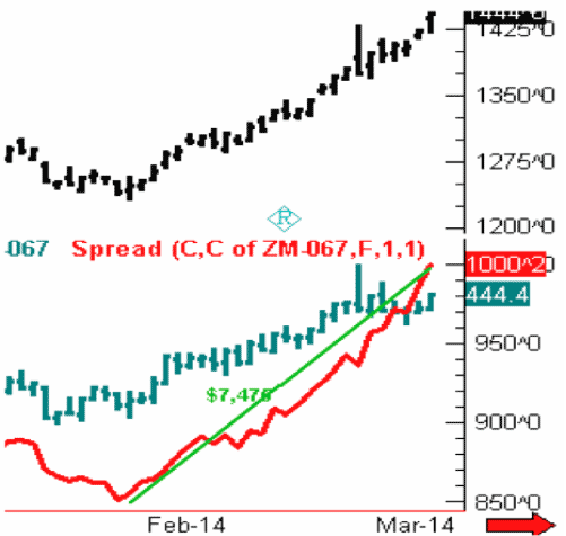
SELF-FORGIVENESS AND RESOLUTION
Joe Ross (Newsletter No. 524)
If your financial losses have injured or hurt your personal relationships, you must apologize and ask those persons for their forgiveness. Most people will forgive you immediately, but whether or not they forgive you is unimportant. It is most important that you forgive yourself and resolve to not repeat the same mistakes. Self-forgiveness and resolution to not repeat mistakes is the best antidote for fear, anger, and guilt, the three emotions of personal and financial destruction. Never use living expense money to trade the markets. Traders should trade only disposable income (an oxymoron if there ever was one)!
Markets seldom make major tops or bottoms based on any one government report. Many traders have a look of shock on their faces when markets fall after a bullish report, but that is what the market wanted to do before the report was released. There is a natural tendency of professional traders to discount reports and state the price action is already in the market before the report was released. Fundamental traders should rate reports as: + = bullish, + + = very bullish, 0 = neutral, - = bearish, and - - = very bearish. I traded cattle in the late 1970's and early 1980's, and the market moved opposite the reports over 60% of the time the next day, and over 70% of the time by the next week!
Yours,
Joe Ross
TRADE WHAT YOU SEE
Joe Ross (Newsletter No. 525)
When you look at a chart, often what you see depends on where and how you draw lines. Are prices trending? Are prices in congestion? If you were going to trade this market today (last bar), what would be your point of view?Color also can make a difference in what you see. However, in one case you see a trending market, and in the other a stair-stepping market in a series of mostly sideways movement.
In the latter part of my trading career, I stopped using color and stopped drawing lines. The only thing that counts is what you are going to do based on the next bar on the chart, and we don't yet know what that will be. You can't trade history, and you can't trade the future. You can trade only the present, and that only as it occurs.
Yours,
Joe Ross
INITIAL CAPITAL VS. EARNED CAPITAL
Joe Ross (Newsletter No. 525)
Traders are always more concerned about protecting their initial capital, rather than gains beyond that amount. In fact, traders become careless with gains beyond the amount of their initial capitalization. For some strange reason, traders do not treat newly earned capital in the same way as they do initial capital. Of course, this is the height of foolishness. There is no difference between initial capital and newly won capital. Capital is capital, and should be treated with respect. Traders seem to feel that new capital belongs to someone else. They feel as though they were trading with someone else's money, and so they treat it carelessly. But capital earned by way of trading in the markets is not someone else's money, it is your money. Once added to the capital base, it should be treated as something precious. You want to be paid to trade. Winnings are your payment for taking risk.
Fear is stronger than greed because it implies the loss of initial capital, and greed implies gain beyond initial capital. This may be why markets fall faster than they rise. In the past, the Dow has fallen over 508 points in one day, but has risen only slightly above 200 points in one day. On the other hand, falling faster than rising does not seem to be true of the currency markets. The reason seems to be because currencies are not absolute in the same sense as other markets. Since Richard Nixon took the U.S. off the gold standard, currencies trade relative to one another. If the dollar index (a basket of currencies closely resembling the composition of the euro) is up, then a currency such as the euro will tend to be down by a similar amount.
Yours,
Joe Ross
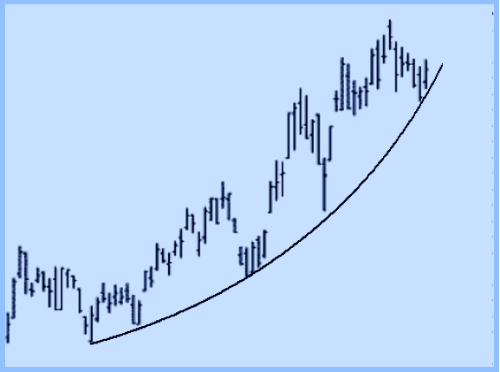
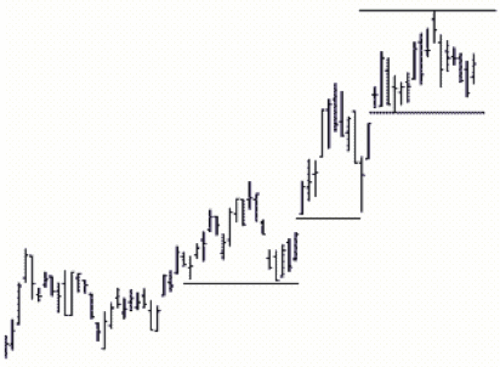
BREAKOUT
Joe Ross (Newsletter No. 526)
The pound against the dollar had been in a trading range during the early morning session, and then broke out when the unemployment report was released. After a strong move up we saw a retracement, leaving behind the first Ross Hook. Using the Traders Trick Entry we enter as shown, and we were able to ride the move for at least 30 pips. Two bars later we saw the next retracement, and we had another possibility to go long using the Traders Trick Entry. We entered and saw another 60-pip move. The third Ross Hook formed in the late afternoon, and we decided not to take it because of low volume.
This is not to say that anyone should sit and trade all day, but when writing issues of Chart Scan I often try to find as many examples as I can of trading throughout the day. I want you to also know that our latest methods of trading the Traders Trick have been changed. If you want to see how we currently trade the Traders Trick, you should attend one of our Traders Trick Seminars. Trading the Traders Trick as we now trade it has resulted in 90.2% winning trades!
Yours,
Joe Ross
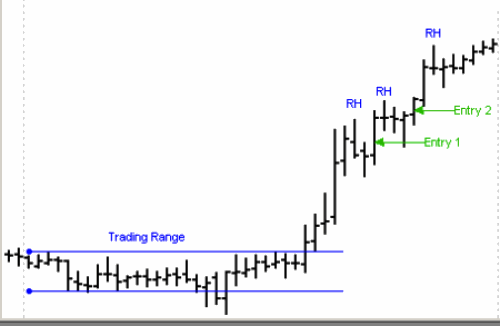
LEARNING FROM LOSSES
Joe Ross (Newsletter No. 526)
Winners learn more from losses than they do from profits. When a profit is taken, there may be little room for improvement. When a loss is taken, a trader's self-discipline is the first thing to be examined. The second aspect of a loss is how did the actual price action cause the loss? Was there a trend reversal; an unexpected gap?
Most beginning traders sustain losses due to emotional reactions. Traders should ask these questions: How could I have improved the trading results on this trade? What did I do right? What did I do wrong? What were the technical reasons for entering and exiting this trade?
Lessons learned from a loss are the price of knowledge gained. It is for purposes of learning that a trader must learn to plan. Comparing actual actions and results with a trading plan will highlight where the trader went wrong.
Consider the case of happy Harry:
Harry saw prices in congestion. Harry was pretty sure that prices were going to breakout to the downside, even though he knew that prices in congestion can breakout in either direction. Harry decided that there was no way that he wanted to miss the move. Therefore, he entered a sell stop 1 tick below the low of the congestion area. Of course, Harry was filled at the open of the following day, actually a couple of ticks lower due to a gap opening.
Harry was sure he was right about the trade, so although the close worried him somewhat, he failed to realize that insiders tend to push prices back into a gap whenever they can. In this situation, there are two things to notice:
1. Harry failed to exercise discipline. He let his opinion override his self-control.
2. Prices unexpectedly gapped, catching Harry with a very bad fill.
What happened in the following days? Prices turned and broke out to the upside of the congestion. And what about Harry? Well, Harry paid the price of his folly!!
Yours,
Joe Ross
THE LAW OF CHARTS
Joe Ross (Newsletter No. 527)
Joe Ross' Law of Charts(TM) is a simple trading concept that works in any market and any time frame! The law of charts always reflects the realities of the marketplace. This week we were seeing the beginnings of what may have proved to be a real dollar rally.
When everyone was talking about dollars, and selling dollars, there came a point in time when there were no more buyers to sell to. When the majority were selling, who was doing the buying? The reverse of this is also true: when many were buying, as in the case of the euro, the only way euro buyers could take profits was to sell. They sell to the public, who are usually the last to join the buying and are usually the ones left holding the bag.
What we were seeing on the chart was at least a temporary setback in euro buying. People call it a correction, and the correction had lasted 3 days. But how can anything "correct" the market? The market is always right. The truth is that we were seeing profit taking.
If prices would fail to violate the high of the last bar on the chart, the percentages dictated that there would be either a trend reversal or an area of consolidation. We would have seen a Reverse Ross hook (the beginning of a move to the downside) if the low of the last bar was violated, or the beginnings of a period of sideways movement. If prices would violate the high of the last bar, then the percentages favor continuation of the trend. This kind of situation is surely a time for caution. Trade what you see, not what you think. In situations such as these, do not form an opinion. Focus on what is actually there!
Yours,
Joe Ross
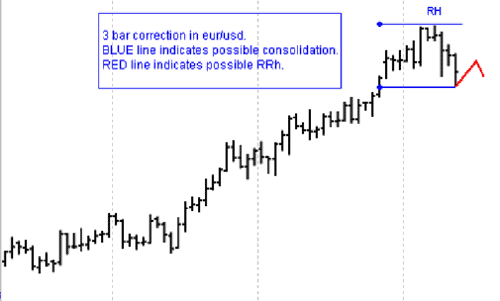
FIND YOUR BIGGEST FINANCIAL WEAKNESS AND FIX IT!
Joe Ross (Newsletter No. 527)
To position yourself for success in investing (and life in general), it's useful to identify the one key area that's holding you back. These factors can range from needing to free up more money to invest each month, to cutting back on frivolous spending, or even a lack of education on how to best manage your investments.
You'd be shocked at how many people are unable to pinpoint obvious blemishes in their financial game plan. Young couples, for instance, often times overextend themselves as far as living arrangements go. Renting a two-bedroom apartment for $1,700 a month and spending the rest of their money on entertainment goodies (electronics, restaurants, etc.) is a fast track to a mountain of debt.
So take a step back and consider what you can do to improve your finances. Freeing up the capital necessary to generate wealth is not hard, but without action, the clock will continue to run. Time will quickly become less of your ally and more of your concern.
Yours,
Joe Ross
REVERSAL BARS
Joe Ross (Newsletter No. 528)
This week I want to show you what can be learned about reversal bars from the chart below. At "A" we see a spike up at the end of an upward swing. The following day prices gap lower and we have what is called an "island reversal." Statistically, island reversals more often than not result in areas of consolidation, but at the time this occurred, prices were still in an upward swing, and had not violated a trend line. This particular "island" is not a true reversal bar because even though the "island" caused by a gap up and a gap down is the highest high at the end of a trend of swing, the close was higher than the open. Nevertheless, the Law of Charts dictates that at this point in time you must be on your guard in anticipation of prices developing into sideways action. At "B" we are given another warning that the move may be over. "B" is a true "key reversal." The close in this case is lower than the open and the reversal is coming at the end of a trend or swing. Prices gapped open higher but closed lower. The very next day confirms the reversal by making a lower high and a lower low, and a swing down (retracement) takes place. Notice: that swing down breaks the upward trend line, another significant indication that the upward move is ending and that prices will probably move into consolidation. What are your choices here? How should you trade this kind of situation? My choice would be to prepare myself for trading in options. There are numerous option positions that can benefit from, in this case, two things: 1. Falling volatility. 2. An expectation of containment within the consolidation affording a chance to sell strangles and straddles -- Calls above the consolidation, and Puts below the consolidation.
Yours,
Joe Ross
MAKING CHOICES
Joe Ross (Newsletter No. 528)
When confronted with a choice, how do you decide?
Are the choices you make in life in general different from the choices you make in trading? It has been my experience that decisions in life that involve a perception of a possible loss, being wrong, or making a mistake, will very often take the same approach as the decisions you make in trading.
Stuck
Gary was a "want to be" trader for over twenty years. He was obsessed about making trading his profession. It was lucky for him that his other business did well enough to support his life. It was very clear to Gary that he had an issue of being afraid to lose and not wanting to be wrong about his choices, but the same thing that kept him from following his rules also kept him from making a decision about overcoming these issues.
A trader friend, who earned a great deal of money as a result of listening to Gary's advice, suggested that he take one on one trading with me. My evaluation of his questionnaire, along with our initial conversation, highlighted everything that Gary already knew and other sabotage issues that he was not aware of. I knew that Gary had what it takes to be a great trader, but was he going to excuse his way out of making the right choice, or continue on the same path of making excuses?
I have listened to many traders whom I believe could be exceptional traders, but because they did not have the ability to pull the trigger on a trade, they could not pull the trigger on doing what it took to overcome those issues.
Here are some of the excuses traders give themselves and me (and what I am thinking when they do):
-
I don't have the time and or money. (Then you shouldn't be in trading.)
-
I will do it but not now, but someday. (I don't know of a day of the week that is called 'someday'.)
-
My wife doesn't want me to spend the money. (It's your responsibility to gain her support.)
-
I need to schedule it around my vacation. (This is a business decision, not a vacation decision.)
-
After I become a profitable trader, I'll then come to you to become a Master Trader. (If you have the ability to do it yourself, then why haven't you done it already?)
-
I have many books on trading, I'll read them first. (You've not read them till now, what makes you think that you have the motivation to carry through with this plan?)
-
It's better for my taxes that I do it next year. (And what'll you say next year?)
-
You're my last hope, if it doesn't work with you, then I'll have to give up trading. (You may already have done so.)
Weighing your choices
When you weigh your choice to get help versus to not get help, you should see the obvious decision:
-
Go back to your last year of trading and analyze what you believe you would have earned if you had followed your rules.
-
Ask yourself how many hours you put into trading.
-
How much is your hourly rate of return?
-
How much would have been your hourly rate of return if you had followed your rules?
-
What has not taking care of your psychological issues cost you in time and money?
-
What excuses do you have that have more value then earning what you are worth in trading?
Conclusion
The choices that you make in the process of becoming a professional trader will make the difference in how successful you will become. It is a good feeling when a trader can look back and know that he/she has made the best choices at every step of the process.
Yours,
Joe Ross
SOME OLD FASHIONED CHART READING
Joe Ross (Newsletter No. 529)
The law of charts is to a large extent about chart reading, and chart reading incorporates some of the observations made by traders over 100 years ago. While these kinds of observations do not follow the strict rules of the Law of Charts, they're interesting, and it is exciting to see them work. Of course we know that nothing works all the time, but it might be interesting to follow what we see on the chart below. The "wisdom of the ages" states that following a breakout from consolidation, if prices shoot up creating what looks like a "flagpole," and are then followed by a flag or pennant formation such as you see on the chart, when prices resume rising, they will rise again by approximately the height of the flagpole. The flagpole begins its ascent at 15.20, which is a violation of the high of the consolidation. Prices then rise to a high of 17.56, so the total height of the flagpole is 2.36. The low of the pennant formation is 15.98. Therefore the projection is that prices will rise to at least 18.34.
Yours,
Joe Ross
THE VOLATILE TRADER
Joe Ross (Newsletter No. 529)
Note: I believe the article below was written by Adrienne Tograhie, a good friend and great trading coach.
The Manic/Volatile trader has learned to create emotional volatility by developing a great imagination. By looping positive and negative stories with more detail, he is very effective in becoming dramatic. With enhanced feelings, he has justified to himself about being right. This keeps him stuck in a loop of emotions and makes it difficult for him to trade. (It is important to note that I am not talking about a person who is clinically manic/depressive. I am talking about a trader who lets his emotions swing out of control.)
Environment that creates this type of trader
In my experience, those who have struggled, suffered great loss, and have known difficult times, especially as a child, have the perfect foundation for becoming a manic/volatile trader. Once this trader type has established a pattern of emotional volatility in his everyday life, the behavior will carry over into his trading life. He will then make radical choices in the markets, which lead to loss. Then what follows is his not taking action on any opportunity.
The other side of the coin
Happy times are over-exaggerated because of how they contrast to the difficult times. Dealing with a Dr. Jekyll and Mr. Hyde personality is difficult in a relationship and adds a double whammy to the trader when he feels the backlash of people's responding to him. Those who live with these types find that they are always waiting for the volatile side to come out. Then the trader does not understand why others fear him when he is being overly happy.
Reality check
I would never put a damper on a trader's belief that he is able to produce extraordinary profits. This is especially true if his confidence comes from good testing results. A trader will find out soon enough when he puts money on the line if his theory works. Statistics will not change his attitude until he faces reality. The reason that I hold back is because there are those few traders whom I have met over the years who did not consider or know what the average professional trader earned in a year, and went on to earn millions from a small account. Of course, this is rare. A manic/volatile trader is often over-confident in his planning stage of trading. He then swings to his depressive side when he realizes that his strategy does not produce the profits he thought it would, even if he is making a reasonable profit.
Using drama to your advantage
Volatile Vic is a good example of a trader who learned to use his ability for creating drama to his advantage. Vic lived in several foster homes that were not at all pleasant. He created his own world where he would escape when he found that reality was too painful. When Vic was fourteen, he lived with a family that was loving and kind. He created havoc in the family, but even with his volatile behavior they stuck by him. For the first time he knew love and security. He went on to study at a Junior College and then earned a scholarship to a university to study accounting and finance.
Vic had a well-paying job as an accountant and was married with two children when he decided to trade stocks. He made a good choice in developing a strategy, but he could not get past simulation. Vic said to me that he was afraid that the monster in him would come out if he were to have any kind of loss. He met me on one of my webinars and decided to take my seminar.
With every exercise he would say, "WOW, that was worth the price of the seminar." Heading off trouble, I suggested that Vic take an acting course, so that he would learn to know how to use his emotions to work for him. He did so eventually, and found another passion. He now works with his local community theater group.
Vic began to use the techniques I taught him in the seminar. After a year of getting moderate results with tight stops, and not allowing his winners their full potential, he decided to do private coaching with me.
In private work we were able to address his issues, and he is now a highly profitable trader. It took Vic two years to give up his day job. He is happy with two new passions that allow him to be free of his self-sabotage.
Exercises for emotionally volatile traders
-
List all of the things, people, and situations in life that you would praise and think of as the best.
-
List all of the things, people ,and situations in life that you think of as the worst.
-
Find in the best things something to criticize. Examples:
-
This person is beautiful, but she has ears that are not perfect.
-
This vacation was the best I have ever experienced, but those long lines that I had to wait in did hurt my back.
-
This trade was perfect - it is perfect only if you follow your rules and not because of what you earned. (Okay, a bit different, but I saw an opportunity here to teach an important lesson.)
Find in the worst things something to praise.
-
This politician did not give me what he said he would when he was campaigning, but considering what he had to deal with it is amazing he was able to get that much accomplished.
-
This vacation was the worst, but I did enjoy that one restaurant.
-
This trade was terrible, but I did follow my rules, and I am learning by my consistency.
Have significant people in your life question you about how you express yourself.
-
You say he is the worst ball player. What can you say that is good about him?
-
He is the best ball player. Is there any room for him to improve?
Give permission to significant people to give a word or a hand signal when you are over-expressing your emotions. Create a repetitious word that can be your anchor such as, "Bla, bla, bla, bla, bla" while clapping your hands.
You would think that I would want to damper only the negative part of the equation, but a trader needs to learn to maintain emotional stability. If a trader gets excited on winning days, and then goes into a depression on losing days, he may hesitate to take a trade even when he sees an opportunity.
Conclusion
Traders who swing their emotions to such extremes have to learn to be less volatile, or they will find that their trading results will also be volatile. With this same imagination the manic/volatile trader can overcome his extremes by understanding how he creates these emotions in the first place, and use that knowledge as a strategy to overcome them. Most traders who experience these emotional swings need outside help, but consider the alternative of not taking care of this issue.
Yours,
Joe Ross
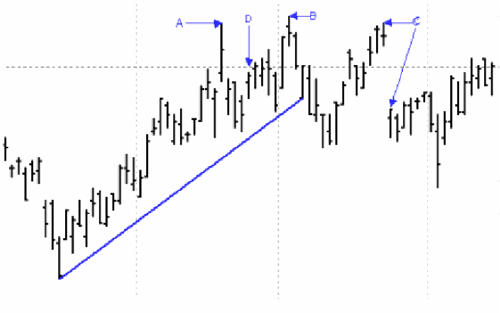
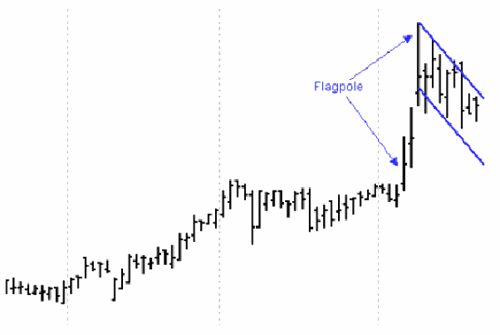
STOCHASTIC CLUE
Joe Ross (Newsletter No. 530)
In my manual Trading by the Book, I stated that if prices break out of a trading range in one direction, and then reverse and come through that range in the other direction, it is time to "sell the store."
However, looking at the above chart, we see that there was little way to know that such a thing would happen after the upside breakout of the trading range. The upside breakout was caused by an economic report. Nevertheless, the Law of Charts came to the rescue by providing a Key Reversal bar.
The question is this: Was the reversal bar telling us that momentum has truly changed, and should we risk going short? After all, the close of the reversal bar was still in the trading range. We had an upside breakout of a trading range, followed by the fact that following the breakout of the trading range, prices failed to go higher. The combination of Stochastics and a reversal bar is discussed in detail in my book "Trading the Ross Hook." There is a way, with a high degree of certainty, to tell whether or not to use the combination to try to get into the trade. The combination reversal bar/Stochastic is a specialized use of the Stochastic study. The settings are nothing special, 5-3-3. It is the use that is special. If the fast stochastic (%K blue line) has crossed below the slow stochastic (%D red line) at the time you seek to enter the trade, then it is a low risk opportunity to enter a short scalp trade using a tight stop for protection. The result of taking the trade was a handsome profit.
Yours,
Joe Ross
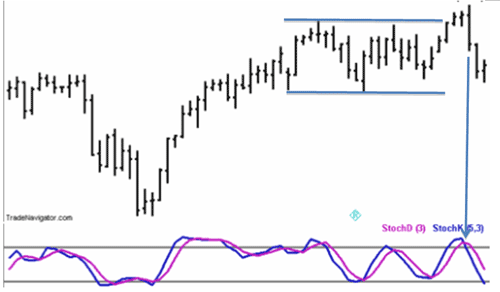
CAREFREE OR STRESSED OUT?
Joe Ross (Newsletter No. 530)
Winning traders approach the markets with an optimal mindset. They trade "in the zone," but it's surprising how stress can impact your ability to enter this ideal state of mind. You can carefully delineate a complete trading plan, for example, in which every aspect is spelled out clearly, from when to enter and when to exit, and you may have a wealth of experience executing such plans, but when you are stressed out, even the most simple task can be difficult to carry out.
You might miss an obvious signal, which would be apparent in a more rational state of mind. When you are nervous and slightly overwhelmed, your psychological perceptions and intuition are restricted and closed off. You miss little things, and have a tendency to respond impulsively.
You may forget to place an order according to plan, or may misread a signal and close out a position too early. These little errors can be frustrating. Are you easily stressed out by trading, or do you approach trading with a carefree, relaxed mindset? Here's a quiz to see how you compare with other traders. If the item is true for you, give yourself a score of 1 for the item. If you think it is false, give yourself a score of 0. Answer true or false for each of the following items, and see what score you get:
1) I often over-analyze an investment decision.
2) I often feel that there is too much information to take it all in.
3) I wish that I had more time to think through my decisions.
4) When I think about my life, I frequently think pessimistic thoughts.
5) I tend to hesitate at critical moments of trading.
What score did you get?
If you received a score of 0 or 1, you scored in the lower quartile, which means that fewer than 25% of those who took this quiz obtained a score as low as yours. Individuals who scored in this range were more relaxed when approaching trades, and reported making profits trading the markets. In contrast, if your score was 4 or 5, you scored in the upper quartile, which means that 75% of the subscribers who took this test obtained a lower score than yours. We found that individuals who scored in this range tended to experience anxiety while trading, had difficulty handing risk, and tended to report mounting losses while trading the markets.
Why are some traders easily stressed while others are more carefree?
Some people are too wrapped up in trading outcomes and how an outcome reflects on their value as a person. They may think, consciously or unconsciously, "If I win, I'm great, omnipotent, and a champion. If I lose, I'm a sorry failure." When you take this approach to trading, though, it can create a roller coaster ride when it comes to your self-esteem. You'll be up one minute and down the next.
Experienced traders report that they make the most profits when they aren't expecting them. They observe the markets openly and freely, and suddenly they make a profitable trade. If you put pressure on yourself, however, you usually choke. Your mind isn't free, but cluttered with feelings of doubt and pressures to succeed. The frustration distracts you, and suddenly you find it almost impossible to make enough winning trades to come out ahead. It's better to trade in a relaxed and carefree manner. It may be difficult to completely view a trade as a leisurely activity, but there is a lot that you can do to make it fun. You can limit risk so that you know that you can handle a worst-case scenario. When you know that you can't possibly lose too much, you will feel at ease. In addition, don't put your self-esteem on the line with your money. It's just a trade. Don't seek out glory. Just enjoy the intellectual challenge of trading. You win some; you lose some. Focus on playing the game and how fun it is. This approach to trading will allow you to think clearly and freely. You will make more profits if you trade with a carefree attitude.
Yours,
Joe Ross
FOREX AND THE LAW OF CHARTS
Joe Ross (Newsletter No. 531)
I apologize for the lack of clarity in the attached picture. It is repeat of a chart shown in 2005. It wasn't very clear then, either. Follow this link to see a bigger image of the chart to the left.
Some people have asked: "Does the Law of Charts work with Forex trading?"
So we will look at a 30-minute USD/CHF chart sent to me by an author who included what you see in his already published book - I cannot tell you the name of the book, simply because I do not know. Also, I must tell you that it is written in Bulgarian, so as much as we would love to offer it to you, I don't think our readership in the Bulgarian language is very large. Of course, any Bulgarians out there are welcome to prove me wrong. We would love to hear that there are thousands of you eagerly awaiting our Chart Scan weekly newsletter! Well, I've said enough.
The chart speaks for itself. It is beautifully done and quite accurate, but you might need to look at it with magnification.
Yours,
Joe Ross
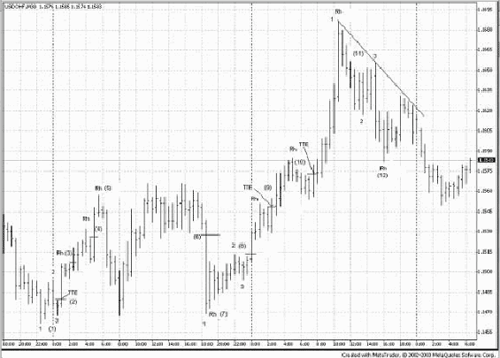
THE DAY AFTER A HOLIDAY
Joe Ross (Newsletter No. 531)
It's the day after a holiday. Are you going to trade today? Some traders believe that stock prices tend to rise the day after a holiday. Perhaps you have anticipated a rise in prices, and are holding a few positions in the hopes that you can sell into the strength brought on by the holiday. Nevertheless, the day before the holiday there's going to be less trading, just by the mere fact that the traders are leaving early.
Who knows what will happen? Historical studies may support the claim that prices go up after a holiday, but history doesn't always repeat itself. You might consider taking another day off. Why not make it a four-day weekend? If you want to trade the markets profitably in the long run, it is essential to get your rest. Trading takes mental stamina, and if you trade the markets too long without a break, you will soon find that you cannot concentrate fully.
Research studies have demonstrated that when people's mental resources are taxed to the limit, they make impulsive mistakes.
Maintaining discipline takes mental energy, and when you use it up, you have to rest. Just like a muscle, when you are worn out, you need to take a break and regain your strength. It's vital to consider that the mind has limited energy, and that after putting in a hard and tedious effort, you must take a rest and rejuvenate, so you can face the market action with a renewed sense of vigor. Holidays are one of the best times to stand aside and regain your composure.
Trading often comes down to performing in a peak performance state at a few key moments. To take advantage of these key moments, you must be relaxed. If you have strained your mental "muscles," you'll have difficulty taking advantage of these opportunities. Your mind will be elsewhere, or you'll be too tired to act decisively. When you're tired, it's hard to gauge market action accurately. You'll be prone to decision-making biases and you may act impulsively because you are too tired to patiently wait for the proper signals to enter or exit a trade. By staying relaxed, yet full of energy, you'll be able to trade in a logical and disciplined manner.
You don't need to perform at a peak performance state every minute of your life. Many people can work for only a limited number of hours a day, and if we try to work in marathon stretches, it eventually catches up with us as is shown by our weak performance. Just as a runner must rest when his or her muscles ache, it's vital to take breaks after a marathon work session.
Part of trading profitably is the acknowledgment of your limitations, and putting together sensible ways to work around them. Don't think you are superhuman. Take a few days off to rest and regain your mental and physical strength. Get plenty of rest so that next week you will be ready to handle whatever the market throws at you.
Yours,
Joe Ross
BUILDING A BASE
Joe Ross (Newsletter No. 532)
Prices formed a base at the end of a trend, and then formed a 1-2-3 low. Prices rose above the #3 point, but due to the gap opening, I personally did not take the trade. I do not trade gap openings as a matter of preference. Actually, the choice is one of 50% - half the time it is the right choice, and half the time it is wrong. There was a chance to enter on backfilling, but whether or not I do depend on my testing of the market to see if I do better than 50% on back-filled orders. If prices would break beyond #2, there are two immediate target zones. The first one would be the gap that formed when prices moved down to squeeze out the last of the bulls. The second one would be that of previous fair value. Prices were steady in the area of the previous trading range. But a move into that area will generally see a test of the highs.
Yours,
Joe Ross
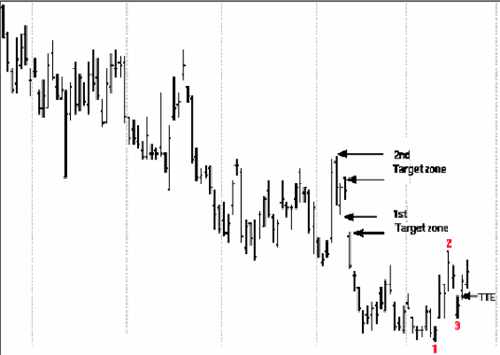
Protection from Losses
Joe Ross (Newsletter No. 532)
You must risk money to make money. It is sad, but true. You cannot possibly make profits in the markets unless you put up the money. Many people hate taking risks, especially with their money.
Risk is a part of everyday life, though. We take risks all the time, even when we complete the most mundane tasks, such as driving our children to school or flying home to visit our family for Thanksgiving. We even take risks while staying home. We can slip in the bathtub, for example. We can't escape risk, but we can take reasonable precautions to protect our interests. When you drive down the street, as you know, it's prudent to wear seatbelts and carefully drive at a safe speed. When it comes to trading, it's also vital to have proper protection. Adverse forces may go against your trading plan, and unless you protect yourself, you run the risk of getting hurt. In trading, that often means substantial hits to your account balance.
You must be able to handle risk in order to trade profitably. When we are afraid to take a risk, we shrink back, paralyzed and defeated. So what can we do? On any given trade, we can alleviate some of the fear by risking a small percentage of our trading account on a single trade, and taking it "one trade at a time," instead of focusing immediately on the onerous goal of achieving a specific return across the entire series of trades. If you can avoid ever thinking of the long-term goal of huge success, you could probably trade forever without hesitation.
There are other obvious ways to feel protected and safe. For example, you can use a protective stop to make sure that you restrict the amount you can lose on any given trade. By looking at the past performance of a stock, you can estimate an ideal stop loss point that protects you, but does not allow you to get "stopped out" too early. Perhaps the most important form of protection, though, comes in the form of a well-developed trading plan. If you know specifically when to enter and when to exit, you can execute the plan even while feeling afraid of losses. You can easily follow your plan, freeing up your mind to focus on your immediate experience rather than the long-term consequences of a trading loss. It's also important to anticipate adverse events as part of your trading plan. Make sure that earning reports or a rate hike announcement isn't going to ruin your trading plan. Careful and precise planning is the best way to protect your account balance.
Just like engaging in a dangerous sport, you feel better when you know that you have some form of protection. Athletes protect themselves with helmets, and airbags and seatbelts protect us as we drive in rush hour traffic. Successful trading also requires adequate protection. Protection not only ensures that you can survive to trade another day, but it also allows you to feel relaxed while you execute and monitor a trade. So protect yourself. If anything can go wrong, it usually does. You don't have to worry, however. If you take precautions, you'll survive the inherent setbacks in trading, and end up winning in the long run.
Yours,
Joe Ross
EURO
Joe Ross (Newsletter No. 533)
Euro had formed a Ross Hook with a Traders Trick entry on the daily chart. Implementation of The Law of Charts teaches that entry signals from a larger time frame are sometimes best entered and managed in a lesser time frame. So let's look first at the daily chart, and then see how we might manage a trade using the chart of a lesser time frame.
Yours,
Joe Ross

ALL IN PERSPECTIVE
Joe Ross (Newsletter No. 533)
As a beginning trader, Chuck had just put on his tenth trade. He was still new to trading, but he was optimistic that he would be successful. He wanted to succeed. He thought, "I want to prove that I'm a good trader. I hope I do well on this trade. The outcome is critical to the rest of my trading career."
Chuck's thoughts and feelings are understandable. Whenever we start a major endeavor - starting college, a new job, or whatever - we want to succeed. And it's nice to have early success. The first few moments of a major life turning point seem especially significant. If we aren't immediately successful, the initial letdown often haunts us for a long time, interrupting our train of thought, and shaking our self-confidence. However, despite the reasonable hope of an early triumph, it's important to keep the proper perspective in approaching trading: you must always think of the big picture, the long run.
Any single trade is of little importance. Experienced traders know this fact, and live by it as if it were doctrine. Even though they may focus all their energy on the current trade, they know it is of little real significance in the long run. It is wise to put each trade in proper perspective. It is essential that you consider, at least in the back of your mind, that a single trade is just one among a series of trades, and that the bottom line is the overall outcome across the series, not any single outcome.
There are psychological advantages to taking this perspective. When you downplay the outcome of any single trade, it is less critical to your ego. When viewed as just one in a long line of trades, it's easier to tell yourself, "It doesn't matter. There will be many more trades and opportunities to come." If there isn't much riding on the outcome of a trade, it will free up precious psychological energy. You won't waste your limited psychological resources needlessly worrying about the outcome. You will feel free and creative, ready for whatever happens next. All your attention will be focused on trading your plan, objectively analyzing how market moves fit into your plan, and taking decisive action for a clean exit.
Putting a trade in proper perspective is not only psychological, however - it also involves proper risk management. To survive the learning curve, or a severe drawdown, you must limit your risk on any single trade. By limiting your stake to a small percentage of your trading capital, the trade will have minimal financial significance. In reality, it will be of little consequence compared with your overall account balance. Merely believing that a trade is insignificant doesn't work very well unless, in reality, it is not significant. For example, it's hard to fool yourself into thinking that a trade is insignificant if you have a month's salary on the line on a single trade, and you can't afford to lose it. The stress can be unbearable. It's important for your psychological and financial security that you limit the risk on any single trade. Again, think in terms of the big picture. You don't need to make money on a single trade; the overall results across a series of trades are all that really matter.
When starting a new endeavor, it's natural to want to do well on every single attempt. All of one's hopes and dreams may be placed on a few key trades. But trading is much too difficult to think you can quickly make a few trades and be set for life, with all your aspirations met. The successful trader is in the game for the long haul. Trading lore is replete with stories of traders who made huge profits, only to lose it all later. You may see some big trades in your career, which will provide numerous war stories that you can use to entertain your friends for hours - but when going into a trade, it's vital to keep the trade in proper perspective. It's still just one trade of the many you will make in your career.
Yours,
Joe Ross
CONFIDENT, PERSISTENT, AND PROFITABLE
Joe Ross (Newsletter No. 535)
Are traders naturally born to trade? Can anyone learn to trade? What is the ideal psychological profile of the winning trader? At TE, we have tried to find answers to these questions, but definitive answers are often elusive. We keep trying, though. We've surv eyed traders and interviewed them. And we have tried to analyze the interviews made by others. Our conclusion: There doesn't seem to be one way to trade, or one ideal trader personality. Consider one real trader, Michael Marcus. Rather than taking a calm, unemotional approach to trading, he often seemed to fall prey to his emotions. He made large impulsive trades - and lost. He sometimes let his emotions get to him to the point that he tried to use medications to gain control. His early experiences didn't permanently trip him up. He learned from his mistakes. His persistence won out, and he eventually learned to trade well enough to make a fortune.
Mr. Marcus was described as "aloof, almost withdrawn." This may be a useful personality characteristic for trading the markets. Aloof and withdrawn people tend to be focused. They may have difficulty dealing with people, but they are also likely to approach the markets with a single-minded passion to succeed. Mr. Marcus is also highly intelligent. He earned membership to Phi Beta Kappa at the prestigious Johns Hopkins University, and won a scholarship to attend Clark University for graduate school. This early academic success clearly gave Mr. Marcus rock solid confidence that carried over into the trading realm. When asked, "Did the thought ever enter your mind that trading was not for you?" Mr. Marcus replied, "No. I had always done well in school, so I figured it was just a question of getting the knack of it."
In our studies of traders, we have found that regardless of whether it is succeeding in sports, academics, or business, the people who develop unwavering self-confidence as a result of their early experiences are the people who persist, sharpen their skills, and master the markets. Mr. Marcus strongly believed in his ability to achieve financial success. But his success didn't come easily. He admitted, "I lost. It was the same old cycle of borrowing money and losing it." Despite making loss after loss, Mr. Marcus persisted until he was able to achieve profitability. At times, he lost over five times his yearly salary, but he kept trading until he gained a wealth of experience to trade the markets profitably.
Of course, not everyone has enough money to be able to lose five times their yearly salary. Even the loss of half a year's salary would be sufficient to put most people forever out of trading.
The markets are difficult to master. Many try, but few make it. Mr. Marcus' interview reveals one of the things it takes to succeed. A winning trader has confidence in his or her ability to succeed. Winning is never guaranteed, and may take the stamina of a marathon runner. It may be necessary to face setback after setback. You may get beaten down at times and feel like giving up. Your emotions may go up and down with your account balance. But in the end, you must believe in your abilities, and that if you put in enough hard work, you will achieve the success you have been seeking.
Yours,
Joe Ross

A LESSON FROM THE PAST
Joe Ross (Newsletter No. 534)
A few years ago, there were times when I had requests from traders in Europe asking if they should be getting long gold, using shares or futures. My answer was: "Gold is not yet truly in a bull market. What you are seeing in the price of gold is a dollar bear market."
Gold had been rising against the U.S. dollar, not against the euro. Whatever someone using the euro made by being long gold, they were giving back in the loss of the purchasing power of the dollar. I think all of our non-U.S. readers should be looking at the ratio of their own currency against the price of gold. However, at one point the picture had changed. Take a look at the chart to the left. As you can see, from November 2004 until January of 2005, gold was actually losing against the euro. So it really puzzled me that European traders wanted to be long gold in any form whatsoever. Gold did not begin to move up against the euro until February. There you see a 1-2-3 low at the end of a swing, followed by a Ross hook, and then a consolidation area. It was only on a Friday breakout that gold began to rise against the euro. My suggestion today is that if you are not already long gold, you should evaluate gold in terms of your own currency to see if this is the time for you to be long. There are, of course, valid reasons to be long gold other than pure purchasing power. Gold can be a good hedge against failing paper currencies. However, keep in mind that, unless gold is rising against your own currency, you are not gaining a thing monetarily by getting into gold.
Yours,
Joe Ross
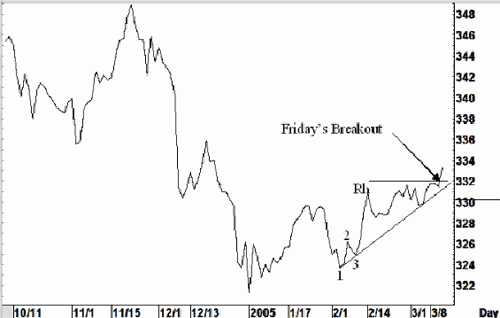
SEEKING PROTECTION FROM LOSS
Joe Ross (Newsletter No. 534)
You must risk money to make money. It is sad, but true. You cannot possibly make profits in the markets unless you take some risk. Many people hate taking risks, especially with their money.
However, risk is a part of everyday life. We take risks all the time, even when we complete the most mundane tasks, such as driving our children to school, or flying home to visit our family for holidays. We even take risks while staying home. For instance, we could slip in the bathtub. We can't escape risk, but we can take reasonable precautions to protect our interests. When driving down the street, for example, it's prudent to wear seatbelts and drive carefully at a safe speed. When it comes to trading, it's also vital to have proper protection. Adverse forces may go against your trading plan, so unless you protect yourself, you run the risk of getting hurt. In trading, that often means substantial hits to your account balance.
We must be able to handle risk in order to trade profitably. When we are afraid to take a risk, we shrink back, paralyzed and defeated. So what can we do? On any given trade, we can alleviate some of the fear by risking a small percentage of our trading account on a single trade, and taking it "one trade at a time" instead of focusing immediately on the onerous goal of achieving a specific return across the entire series of trades. If we can avoid ever thinking of the long-term goal of huge success, we could probably trade forever without hesitation.
There are other obvious ways to feel protected and safe. For example, you can use a protective stop to make sure that you restrict the amount you can lose on any given trade. By looking at the past performance of a stock, you can estimate an ideal stop loss point that protects you, but does not allow you to get "stopped out" too early. Perhaps the most important form of protection, though, comes in the form of a well-developed trading plan. If you know specifically when to enter and when to exit, you can execute the plan even while feeling afraid of losses. You can easily follow your plan, freeing up your mind to focus on your immediate experience rather than the long-term consequences of a trading loss. It's also important to anticipate adverse events as part of your trading plan. Make sure that earning reports or an interest rate hike announcement isn't going to ruin your trading plan. Careful and precise planning is the best way to protect your account balance.
Just like engaging in a dangerous sport, you feel better when you know that you have some form of protection. Athletes protect themselves with helmets, and airbags and seatbelts protect us as we drive in rush hour traffic. Successful trading also requires adequate protection. Protection not only ensures that you can survive to trade another day, but it also allows you to feel relaxed while you execute and monitor a trade. So protect yourself. If anything can go wrong, it usually does. You don't have to worry, however. If you take precautions, you'll survive the inherent setbacks in trading, and end up winning in the long run.
Yours,
Joe Ross
BREAKAWAY GAPS
Joe Ross (Newsletter No. 535)
A breakaway gap can be very convincing of a real trend. Until prices broke away (at the arrow), prices were basically swinging in a sideways trading range. Prices looked at one point as though they were finally trending up, but then they started swinging down again. Finally, just before the breakaway gap, prices made an upward swing to challenge the most recent highs. You can call it what you want: a trend, an Elliott Wave 3, a Fibonacci expansion, etc., but the truly convincing dynamic was the breakaway gap. After that, prices were searching for new levels.
Yours,
Joe Ross

GETTING IT RIGHT
Joe Ross (Newsletter No. 536)
Sometimes it is really hard to get it right. What I mean is: "How do you label a chart that looks like this?" (pls. see left). There are actually three 1-2-3 formations, which have formed in a very short period of time. Is there some kind of virtue in correctly labeling this chart?
I'm going to ask you two questions:
-
What can you do with a chart like this?
-
Why is there any compulsion to trade it at all?
Let's say that you have been trading this market. Is there anything that says you have to keep trading this market? Are you married to this market?
If you have married this market, and you find yourself in this kind of situation, it's time for a divorce. It's time to find a better market situation in which to trade. I'll let you in on a little secret. I try to never trade in a situation in which it is hard for me to tell which way prices are moving.
Ask yourself, "Is the 5-minute E-mini S&P 500 the only place I can trade?" I have watched traders beat themselves to death like a moth throwing itself into a flame, and it never occurs to them that while they are losing their shirts in total frustration on a 5-minute E-mini chart, that they could be making a fortune in some other market that is clearly making piles of money for those who are trading there.
Do you have tunnel vision? Are you wearing blinders? If your answer is yes, you need to do a bit of self-examination. Look into a mirror. The self-made victim you see there is you.
Yours,
Joe Ross
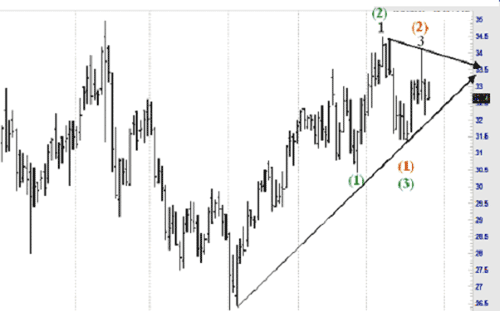
RISK MANAGEMENT:
PROTECTING YOUR ACCOUNT BALANCE AND YOUR EMOTIONS
Joe Ross (Newsletter No. 536)
The markets go up and down, and so will your account balance if you are not careful. Winning traders manage risk. There are many ways to manage risk. Some traders patiently wait for high probability setups, while other traders limit the amount of money they risk on any given trade. What strategies do you use to manage risk? How do you compare with other traders?
A group of traders were asked to take the following true-false quiz. If the item was true they were to give themselves a score of 1. If they thought it was false, they would give themselves a score of 0.
You can take the same test. Answer true or false for each of the following items, and see what score you get:
-
I stick to my stop loss rules regardless of how I feel when the price approaches my stop-loss point.
-
I never risk more than a small portion of my trading capital on any given trade.
-
Before I make a trade, I always determine my risk limit and my profit strategy, taking into account my capital.
-
I keep records of my past trades and carefully analyze them from time to time.
-
I always develop stop-loss rules before executing a trade.
What score did you get? If you received a score of 0, 1 or 2, you scored in the lower quartile, which means that less than 25% of the traders who took this quiz obtained a score as low as yours.
In an analysis of the testing, it was discovered that individuals who scored in this range were stressed out while trading. They experienced unpleasant emotions, lacked discipline, and had low self-esteem.
In contrast, if your score was 5, you scored in the upper quartile, which means that 75% of the traders who took this test obtained a lower score than yours. We found that individuals who scored in this range tended to approach trading in a carefree manner, showed self-control, and preferred a logical well-planned approach to trading.
How well do you manage risk? Managing risk not only protects your account balance, but it also helps you control your emotions. In this study of traders, it was discovered that traders who managed risk were less stressed out and tended to experience positive emotions. These findings suggest that you will feel calmer if you minimize risk. If you are not doing so now, it's easy to start taking some basic precautions. For example, develop a well-formulated trading plan before you execute a trade. Determine how much risk you are taking up front, and decide if you want to actually take that risk. When used properly, by accounting for price fluctuation, protective stops are another effective way to minimize risk. Risking only a small portion of your account on a single trade is also useful. If you truly feel that risk is at a minimum and bearable, you will feel safe and relaxed. And when you feel relaxed, you will be able to trade more freely, creatively, and profitably.
Yours,
Joe Ross
DIVERGENCE - TRUE AND FALSE?
Joe Ross (Newsletter No. 537)
We read a lot about 'divergences' in the markets. Divergence is characterized by prices going in one direction, and an indicator going in another. However, can you trade based on divergence alone? Some traders try to do it. They will look at divergence and tell you that prices are about to reverse.
We can see an example of divergence by looking at (SPY) above. The blue arrow highlights the direction of prices, which are going up, and the red arrow points to momentum, represented by the moving average convergence divergence (MACD), which is going down. The divergence can be interpreted as bearish for SPY, but when? The divergence has been going on for a long time.
Divergences, and their actual ability to forecast trend reversals, might be more easily understood if we realize that momentum by itself is meaningless when it comes to making predictions about the movement of prices. More important is the realization that momentum is also rather meaningless when it comes to making predictions about the markets.
Let's look at that chart of SPY again, but this time the arrows highlight a time when momentum confirmed the price action. Was either price momentum or indicator momentum able to predict what was to happen to prices? (Blue Box)
Here's the problem with momentum - when it is used alone without some kind of confirmation, it is nothing more than a guess. At times it will seem to predict correctly, but at other times its predictions will fail.
One of the really silly things that many traders do is to look for confirmation from another momentum indicator. Posting RSI, Stochastics, DEMA, or %R for confirmation has to be the height of ridiculous. Yet many times we see traders doing exactly that. Wouldn't you expect one momentum indicator to confirm another momentum indicator?
We could continue looking at the chart of SPY and find numerous examples of divergences that worked or failed, and confirmations that worked or failed.
We could easily find examples of whatever we want to show on the chart. And that demonstrates why divergences are not that valuable -- they simply confirm our opinions rather than predict what will happen.
You will continue to hear about divergences whether stocks move up or down. The ones that work will be shown as proof that divergences are important. The ones that don't work will be quickly forgotten and replaced by a new one.
No one ever seems to consistently make money from divergence analysis. It is probably best to view divergences as "for entertainment purposes only" and make investment decisions based on firm rules, and detailed plans.
Yours,
Joe Ross
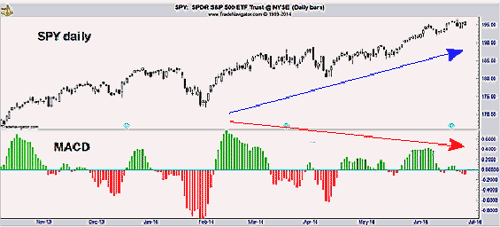
WISHING UPON A STAR
Joe Ross (Newsletter No. 537)
When you wish upon a star, what do you wish for? If you're like most people, financial freedom is one of the first things on your list. If you had a million dollars, think of what you could do. You wouldn't have to ever work again. You could just sit on the beach and relax. But if you're like most traders, you couldn't stay away from trading even if you had infinite wealth.
What else could you wish for? A crystal ball, perhaps, or tomorrow's newspaper. You would want to know what was going to happen tomorrow. You could anticipate market moves with unfailing accuracy. Think how easy trading would be! Wouldn't it be nice to be able to predict the future?
It's fun to wish that we could trade more profitably, but wishing can often be a sign of desperation. When we are in wishing mode, we wait passively instead of taking decisive action. We hope for miracles, and wonder if we'll ever see huge profits. But if we take proactive steps, we won't have to wonder. If we set our mind to it, and work hard enough, we will be successful. Through hard work and determination, we can make our wish of becoming a winning trader come true.
Would it be nice to have a crystal ball? Yes. We could trade without fear. But who needs a crystal ball? Winning traders have sharpened their skills to the point that they don't need a crystal ball. They have methods that work across a variety of market conditions. They may not win on any single trade, but their methods give them an edge. If they make enough trades, the law of averages works in their favor, and they end up profitable. They trust their method, trade with discipline, and after a series of trades, they are profitable.
Can you predict what the markets will do? Not always, but experienced traders rely on their wealth of trading knowledge. More times than not, they can accurately anticipate what the markets will do.
Do trading patterns work like clockwork? No. Do they work a lot of the time under particular conditions? Yes.
What experienced traders know, and so should you, is how specific markets move according to world events, media reports, times of day, or whatever unique factors impact the price. Nothing is certain, but the more knowledge you have about a market, the better you'll be able to anticipate how prices will move. And if you can stay ahead of the other traders, you can profit.
You don't need to hope for a miracle. All you have to do is study the markets and develop an intuitive feel for how they move. Once you develop these skills, you could anticipate the markets almost as well as by having a crystal ball.
Yours,
Joe Ross
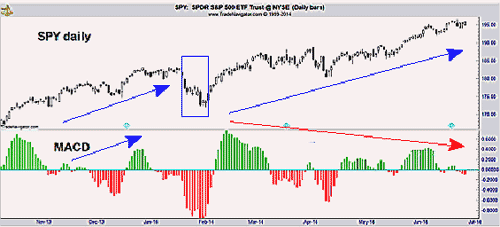
AVERAGE TRUE RANGE (ATR)
Joe Ross (Newsletter No. 538)
A question came in a few days ago asking about ATR, and how it fits into The Law of Charts (TLOC). Please realize that TLOC is not a trading method or a trading system. It is the foundation upon which price charts are built. TLOC describes human reaction to the movement of prices by defining certain formations. The simplest manifestation of price is seen in the form of a simple bar chart. You can't get much simpler than a single price bar stripped of any open or close, nothing more than a vertical line depicting a range of values from high to low. No other form of chart can approach that level of simplicity.
ATR takes the value of the range of any number of those bars from high to low and averages them to determine the volatility in the market. The value of a single bar's volatility is determined by taking the difference between the low the high.
Be aware that there is more than one way to determine the value. The simplest is high - low, but that fails to take into consideration any gaps. If you want to include the value of gaps, then you are faced with a problem. It is the decision as to how to treat gaps that is the main reason why different software algorithms arrive at different answers for the value of the ATR.
Picture, if you will, two price bars, with the second one gapping up in its entirety above the high of the first price bar. How you treat such a gap will be the main factor in the answer you get for ATR. Did prices move:
-
From the low of bar 1 to the high of bar 2?
-
From the close of bar 1 to the high of bar 2?
-
From the high of bar 1 to the high of bar 2?
-
From the low of bar 1 to the low of bar 2?
-
From the close of bar 1 to the close of bar 2?
-
From the open of bar 1 to the open of bar 2?
-
From the open of bar 1 to the high of bar 2?... Etc.
Obviously, I left out a few other possibilities. But which one is correct? It turns out to be mostly a matter of opinion.
There are other factors that determine the reading for ATR that you see on your software:
-
How many decimal points are included in the value? The chart above shows 4 decimal places.
-
How does the software do the rounding?
-
How many bars are included in the computation?
The chart above shows ATR as computed by Genesis Trade Navigator on a ten-minute chart utilizing 20 bars (brown line). The blue line is the way Trade Navigator computes "Wilder's ATR." But even that is not the same as the way others do it. There are times when the two are substantially different from one another, and substantially different from the calculation of others.
What is a trader to do? Should you aggravate about the way the software you use calculates ATR? There's an old saying I heard in Texas: "Dance with the one that brung ya." In other words, use whatever there is in the software you are currently using.
Yours,
Joe Ross
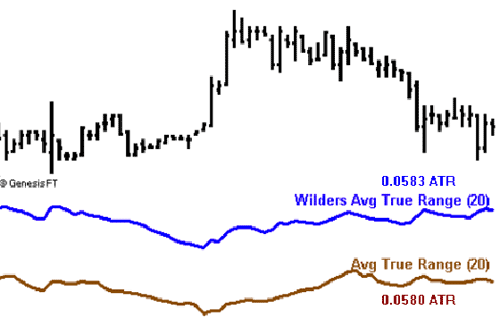
THE CYNIC AND THE REALIST
Joe Ross (Newsletter No. 538)
In the trading business, it's prudent to take everything you hear with a grain of salt. Our field is full of false prophets who claim they can make you rich quickly and easily. Realistic skepticism is healthy. For example, there are many traders who made huge profits in the late 90s, and now claim that they can help you live comfortably by trading a $10,000 account. How do you do it? It's easy, they claim. All you have to do is buy 200 shares of a $50 stock, wait for it to go up $1, and make a $200 profit in as little as 30 minutes. That's $400 an hour, $800,000 a year. Is this realistic? It doesn't seem to be. Sure, you can invest $10,000 on one trade, pick a stock that goes up $1, and make a $400 profit, but can you do that over and over again? Won't there be times when it goes down $2? What about those times where you try to sell off the position, but you can get the $1 increase for only part of your position?
Can you make a winning trade hour upon hour, day after day, without fail? It's appealing. Who wouldn't want to believe it was true? But anyone who has traded the markets knows that it's hard to make winning trades over and over without making a few losers, at a minimum. You can't pin all your hopes on one trade, and you can't realistically believe that you'll be able to repeat the process over and over again without fail. You must manage risk and constantly entertain the idea that you'll hit upon a losing streak. It's better to take a more realistic, practical approach to trading. It's vital to be a realist.
What's a realist? Realists understand that unpleasant surprises come with the territory. Caution, due diligence, and step-by-step planning are valuable, sometimes indispensable, but they don't guarantee smooth sailing.
Realists don't look at the world through rose-colored glasses, but they don't look at the world through dark-tinted glasses either. Both over-optimism and fatalistic pessimism are distortions of reality. Realists find a balance between the two extremes. They are open, flexible problem solvers. The cynic takes the attitude, "you can't fight city hall," but the realist believes there are times where you can work hard and do the impossible. It won't work all the time, but many times it will.
When cynics put on a trade that is ruined by adverse events, they pessimistically think, "I got a raw deal." Cynics aren't ready for the unexpected. They view setbacks as evidence that the world is corrupt. They secretly believe that it's impossible to make money in the markets and they are looking for evidence to throw in the towel.
Realists know that unexpected adverse events are commonplace when trading the markets. Nothing is completely certain. It's a matter of probabilities.
While cynics view the challenges of trading the markets as a reason to find a new profession, realists are open to change. They expect things to go wrong occasionally, and they are ready to deal with them. The realist is ready to rise to the challenge and work around the problems. They manage risk. They are on the constant lookout for new trading methods, and they know that they can't passively wait for trading opportunities to come to them. They search for them, and stay ahead of the masses.
Be a realist, not a cynic. Think positively, but don't distort reality. Don't fall for "get rich quick" schemes. Get quality training and build up rock solid trading skills. With enough persistence and effort, you can master the markets. There may be many setbacks, many losing trades, and endless dings to your ego, but if you are open to new experiences, and believe you can overcome any obstacle with hard work and persistence, then you will trade profitably and achieve enduring financial success.
Yours,
Joe Ross
A FOREX TRADE
Joe Ross (Newsletter No. 539)
Let's look at an intraday trade I made in EUR/USD. The trade exactly fits my parameters for Forex trading, but could also have been done using the futures markets. The method I am describing is found in full in my "Day Trading" manual. The Friday I made the trade was a great day to look for this kind of trade. Prices had been mostly sideways all week, waiting for a bunch of government reports to come out. There was no way to tell which way prices would run, but it seemed evident that any moves would be explosive -- it turns out they were just that for short-term traders. The Law of Charts states that the best way to anticipate breakouts from trading ranges lacking any other definable formations, is to simply place entry stop orders just above and below the areas of consolidation. Any consolidations consisting of 21 bars or more are considered to be trading ranges, with the greatest percentage chance for a breakout coming on bars 21-29. The trading range may be defined as the latest 21 bars to occur with the first bar being a bar that best defines the vertical midpoint of the consolidation area. The first breakout came on bar 22, and the second on bar 24.
Yours,
Joe Ross
BELIEFS ABOUT MONEY: A POSSIBLE SOURCE OF SELF-SABOTAGE
Joe Ross (Newsletter No. 539)
Do you have trouble following your trading plan? Many novice traders do. They develop a plan with specific guidelines as to when to enter and when to exit. The night before it all seems so clear, what they are going to do and how they are going to do it. But when the markets open the next morning, they are persuaded by a little voice to throw the plan out the window. It's a common ailment, and many times people abandon their trading plans because they secretly don't want to make money as a trader. They don't know how trading fits into their lives.
They question whether they should be trading, and they secretly believe that it is wrong to make money. Often they think it hurts another person. If you have these beliefs, it is vital that you identify them, and change them, before you continue to sabotage your trading efforts.
Have you ever heard the saying, "Money is the root of all evil"? Is there any truth to that belief? The saying comes from the Bible, but it is misquoted, as I will explain just ahead. Some people believe that money is corrupting, and that anyone who has it is corrupt. Some people think that people with money are greedy, unprincipled, and insensitive, and that it is cleaner, purer, and more virtuous to live with only a minimum amount of money. If you hold these beliefs, even if it is in your subconscious, you don't have a chance of having money and living prosperously.
Many people believe that the saying, "Money is the root of all evil" is a warning from the Bible, but the actual meaning of the Biblical passage is quite different. The Biblical phrase in the book of Timothy is, "The love of money is 'a' root of all kinds of evil." It is the lust for, and coveting of money for its own sake that is problematic. Money in and of itself isn't evil. Let's face it, money isn't even real! It's a human abstraction. You can't eat money. You can't build a house with money. Money is just intangible currency we use to purchase concrete goods and services.
What you do with money is up to you. If you want, you can build a homeless shelter, or start a charity with the money you make. Money isn't evil. It's what you do with it that counts. Some traders find it useful to set aside a portion of their profits for charity. It allows them to know deep down that should they do well as a trader, they can make a clearly defined social contribution. Other traders see trading as a way to take care of their family, a very noble motive.
If you are holding back because you believe that it is wrong to make money by trading, it is important to explore this belief. Traders have many reasons to make profits in the markets. It isn't merely an aimless quest for money. Professional traders have a rare talent, and feel fulfilled because they express their talent by trading profitably.
If you are trading merely to acquire money in order to gain fame and status, you probably won't last very long. But if you remind yourself of the more noble motives for trading, such as taking care of your family or making a social contribution with some of your winnings, you will feel more at ease as you trade. You won't think of yourself as "corrupt" or "indecent." It's vital that you look deep inside yourself and identify why you trade. If you truly believe it is what you are meant to do, you'll be more willing to put in the time and effort to sharpen your trading skills. The little voice in the back of your mind will be optimistic and upbeat. You'll think, "I'm doing the right thing."
Rather than sabotage your efforts, you'll cultivate discipline. You'll work hard, practice trading techniques, develop a solid knowledge base - and soon, you'll become a profitable, disciplined trader.
Yours,
Joe Ross

MONTHLY CHART TO GET THE BIG PICTURE
Joe Ross (Newsletter No. 540)
Most of the time when I am dealing with the stock market, I prefer to get the big picture. For this purposes, I use the monthly chart. Recently I temporarily exited a trade because prices had risen so steeply. When prices become parabolic is often a time to take home some profits. Prices broke out from a massive multi-year consolidation and then retraced -- a very common pattern for any type of chart to make. You might call what I did "Classical Chart Analysis."
Subsequent to the breakout, prices corrected, leaving behind a Ross Hook and a Traders Trick. Entry was made at the arrow for a very nice trade. At the very top, there was a monthly reversal bar, which after such a dramatic move was my signal to consider exiting the trade.
Yours,
Joe Ross

ACCEPTING THE CHAOS
Joe Ross (Newsletter No. 540)
A bird flaps its wings. A storm strikes miles away. According to Chaos Theory, a seemingly irrelevant action can precipitate, and contribute to, a major event. The right set of factors comes together, and a major event takes place. It's easy to imagine an unlikely chain of events that may initiate a market move. A housewife attends to her crying child who has tripped over the newspaper, and in doing so, leaves the refrigerator open during an unseasonably warm day. It breaks down, and the family needs a new one. To get funds for a new refrigerator, she sells off a large chunk of IBM stock that her parents gave her as a wedding present. By pure chance, at the moment that she sold the stock, a specialist monitoring the action gets it in his head that the sale of a large chunk of stock means something, so he sells off his positions in the tech sector. Next, a financial reporter sees the sale and tries to interpret it. He reports that it reflects a shortage of silicon and suggests investors unload their tech stocks immediately. Many people follow his advice and a massive sell off takes place. Perhaps it seems a little unlikely that all of this can happen, but you get the idea.
Just as scientists claim, according to Chaos Theory, that a butterfly can start a storm, you can imagine that a few key, seemingly minor events, can start a major market move.
Many investors view the markets from a traditional long-term buy-and-hold strategy. They look at the markets in terms of fundamental variables, such as consumer confidence, demand, and general economic factors that impact a stock price. If a company makes profits that are in high demand, the price goes up. Short-term investors, though, realize that many market moves are the result of psychological factors, such as opinions or emotions of fear and greed. In the short-term, anything can happen, and it's vital to keep this in mind.
Nothing is certain in the markets, but is this something to worry about? Not if you take precautions. Indeed, a potential chaotic event can be a good thing. The initial event that sets off a market move isn't important. Who cares why the masses buy or sell, for example, as long as you take advantage of the move? Some may view such moves as excellent opportunities to profit. On the other hand, if you have a swing trade that is ruined by an unexpected adverse event, the chaotic nature of the markets can be a hassle. But such events still aren't worth worrying about. All you have to do is anticipate them, and take precautions. By using a protective stop, for example, you can avoid losing money when an adverse event unexpectedly occurs.
In the end, it's necessary to accept the risky nature of trading. Anything can happen, but it doesn't need to be a source of worry. Through careful risk management, you can protect your capital. And occasionally, an unexpected event can turn a mundane trade into a big winner. Worry can be the doom of many traders, but if you accept the fact that uncertainty and chaos are part of the inherent nature of the markets, you can account for it in your trading plan, and neutralize its potentially negative impact.
Yours,
Joe Ross
WEEKLY CHART TO GET THE BIG PICTURE
Joe Ross (Newsletter No. 541)
A few years ago I was looking at the weekly euro vs. the U.S. dollar in order to pick up the trend, and also to also observe what to do when I had a thrust bar at the end of a swing. You could have seen a similar weekly chart of the euro-fx futures.
As you can see on the right of the chart, according to the 50-week moving average, the euro was still in an uptrend. The 50-week moving average shows almost perfect containment of the trend.
Below the chart is a 5-3-3. Stochastic. The fast stochastic (at the arrow) is about to cross the slow stochastic moving upward. At Trading Educators we are not much on using indicators unless we can find a special use for them.
Thrust bars at the end of a swing are when we look to a short-term Stochastic for some confirmation of a change in momentum. This time the change is from downward to upward momentum.
When you put these technicals together with the fundamentals of a weakening dollar, you have the ingredients for an upward swing in the euro. While currencies swing wildly on the intraday and daily charts, the weekly chart gives you an opportunity to stand back and get the big picture. We use the bigger picture to plan our long-term investment strategies. We use the stochastic to help with our timing.
Yours,
Joe Ross
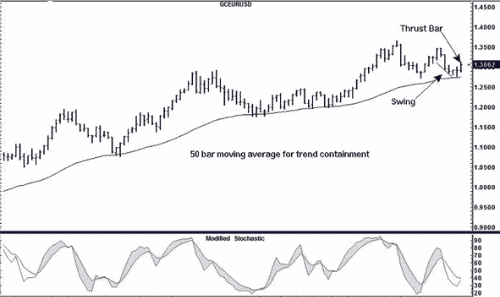
HAPPY TRADERS SEEK OUT BALANCE
Joe Ross (Newsletter No. 542)
Trading is a challenging business. Only the most skilled traders can make a living as an active, full time trader. Trading experts suggest that novice traders approach trading the same way that students pursue their vocation in professional school, which requires a resolute dedication to sharpen their skills in order to move to the top of their field.
The seasoned, professional trader has rare and valuable skills, like those of a lawyer or a doctor. You have to limit your social life and focus on developing your skills if you want to be at the top of your class. Think of the interns and residents at a hospital emergency room, or the law students on a crucial case. They focus all their efforts on learning about their profession, even if it means sacrificing their social life. During the learning process, it requires a life with little balance between work and pleasure. Is it a good idea, to be so unbalanced? It depends on how you define happiness. For some, the heavy upfront price is worth what they get for the rest of their lives.
The trick to paying a heavy price to achieve success is to enjoy the process as much as you can, and try to maximize your positives by readily dedicating yourself to the goals that are likely to be rewarded. This approach can be true for trading. It's important that you enjoy the process of trading, but should it be the driving force in your life? Maybe not! I believe it's important to always have a life.
Many novice traders work under the assumption that because they're putting their money on the line to pursue trading, they should give it their all. Is it necessary?
A study was done in which a group of traders were asked to fill out a questionnaire regarding their emotional mood. The sample was divided into happy and unhappy traders, and a comparison was made. Compared with unhappy traders, who reported a tendency to feel disappointed, frustrated, and discouraged, happy traders reported that they enjoyed the process of trading. They liked the intellectual challenge trading provided. They enjoyed learning about how companies made a profit. They enjoyed learning about new strategies, and enjoyed learning about how people made money in the markets. These responses are consistent with my suggestion to "enjoy the process."
When asked if they allowed their personal relationships to suffer as a result of devoting too much time and energy to trading, the answer was "No."
Happy traders were clearly dedicated to improving their trading skills, and enjoyed doing so, but they didn't allow their relationships to suffer as a result of their dedication. This is a valuable lesson to learn: Pursue trading earnestly, but also seek out psychological balance. Don't think that trading must be your whole life. Spend time with family and friends. That's what happy traders do.
Yours,
Joe Ross
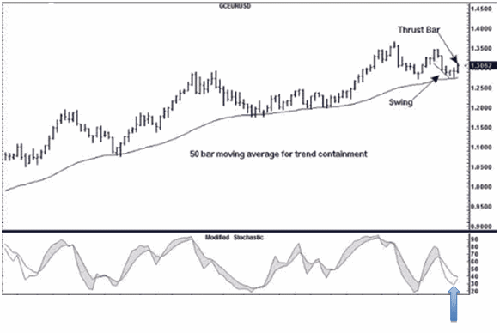
HOW WOULD YOU TRADE THIS CHART?
Joe Ross (Newsletter No. 542)
From time to time someone will send me a chart that looks like the one below. Along with the chart comes the question: "How would you trade this chart?" The answer usually is "I probably wouldn't trade it at all."
This brings up the topic of marrying a market.
Looking at the chart below, it is not clear as to which way prices will move next. With many markets available for trading, who is to say that I have to trade what is on that chart? Why not look for a chart in which the price action is more precise? Why not look for a chart where prices are clearly in a trend, or a chart where prices have just broken out of a long congestion, and you can clearly see what action to take?
Why is it that traders pick one market and stay with it, even when that market is chaotic and confused? Have you married a market? What a terrible mistake it is to do something so foolish. There is no need for loyalty to a particular market. Yet, we hear it all the time. "I'm going to trade the e-mini S&P on a 5-minute chart." If you own a brick and mortar store, you are heavily dependent on people's finding and coming to your store in order for you to be able to make money. However, if you are a trader, you can go to any market. You don't have to wait for the market to come to you. If you realize that you are married to a market, it's time to get a divorce.
Yours,
Joe Ross
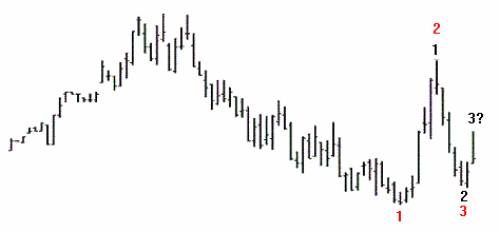
BUILDING EMOTIONAL TOUGHNESS
Joe Ross (Newsletter No. 542)
Emotions are what drive the markets. The markets are not driven nearly as much by world events as by how people respond emotionally to those world events.
The most important factor in increasing performance is emotional.
Consumed by anger, fear, doubt, or hopelessness, you lock up inside and fall short of the mark again. What is possible for you remains tragically out of reach. Unless you experience a full range of emotions, and become emotionally tough, you'll have trouble achieving a higher level of performance.
How do you become tougher emotionally?
According to an expert on the matter, Dr. Loehr, there are four indicators of emotional toughness: flexibility, responsiveness, strength, and resilience. By working on each of these areas, you can develop the emotional skills you need to improve your performance.
Emotional flexibility is the ability to be open, expansive, and non-defensive in the face of a crisis. There's a strong tendency to blow a minor setback out of proportion and respond inflexibly. For example, when our trading strategy goes awry, or we face a temporary drawdown, our first inclination is to avoid the problem rather than to experience a range of emotions, such as a fighting spirit, humor, or enthusiasm. It's important to experience a little bit of fear, but once you go there, it's even more vital to think creatively, problem-solve, and get past it. If you are open to different emotions, you'll have an easier time moving forward, rather than remaining stuck and paralyzed.
It's also important to be emotionally responsive. When facing a crisis, many people want to shut out their emotional experience. They are withdrawn and distant, estranged from their ongoing experience. But it's essential to remain open to experience and ready to respond actively and creatively. If your trading method is failing, for example, it's important to energetically try to revise it. You must actively study the markets, be open to current market conditions, and accept them. Once you connect emotionally with the markets, you can find new solutions that weren't obvious at first glance.
When facing a crisis, even a minor one, emotional strength and resiliency allow you to constantly exert a positive force to change matters. Rather than back down in defeat, it's vital to show unfailing persistence. You must be able to quickly bounce back from a setback. Rather than be deterred, you must keep your overall goal in mind and keep striving for it.
Winning traders are emotionally tough. They are open to a wide range of emotions, stay connected to their ongoing experience, stay positive, and bounce back from a setback quickly and easily. The more you can build emotional toughness, the more rapidly you can enhance your trading performance.
Yours,
Joe Ross
MUTUAL FUNDS
Joe Ross (Newsletter No. 543)
We received a question asking whether or not the Law of Charts works with Mutual funds. The answer is "Yes." You can see all of the Law of Charts formations on any chart of mutual funds.
For those funds that do not show daily bars, only closes, it is best to use a weekly chart to get the big picture, or simply connect the daily closes with a 1-day moving average to create a line chart of the daily price action.
The chart shown above is Vanguard High Dividend Yield fund (VYM), which, as you can see, has been in a long-term uptrend. The chart shows the entry on a breakout from a Trading Range on exactly the 21st weekly bar. The breakout is that gap bar you see as prices break out of the Trading Range. The Law of Charts states that breakouts from consolidations are most likely to occur on bars 21-29.
Following the breakout, you see a series of Ross Hooks (Rh). Since trend supersedes congestion, although prices have begun forming another consolidation, the trend is still in effect.
Yours,
Joe Ross
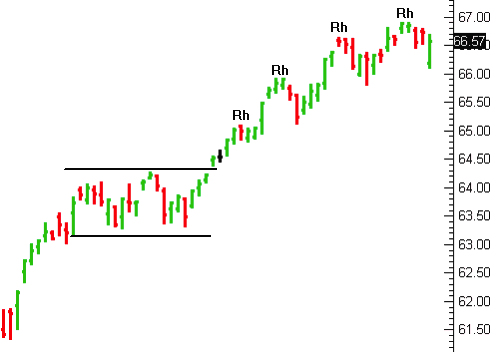
INCREASING MENTAL CAPACITY
Joe Ross (Newsletter No. 543)
Trading can be a complex activity. A broad range of information must be studied and integrated. Not only do you need to keep up on possible news and factors that may impact the market action, you have to look at indicators, such as price and volume, in order to anticipate where the market will move next. And it isn't easy to identify chart patterns.
It can be a lot like putting structure onto an amorphous pattern of lines. If only we had more computing power, we could process all the information we needed to trade more efficiently. Unfortunately, the mind has limits. And you have to work around them.
The mind is like a computer. We store memories in the hard drive, while our ongoing experience is processed by the CPU and stored in RAM. The amount of attention you can devote to a particular task is restricted. You can only attend to, and process, a limited amount of information, and when you move beyond the limit, the information is not processed. Have you ever noticed that it is possible to read a telephone number and remember it for only a short time? When you are distracted, the information is lost. Unless you memorize the information, it is lost.
How can mere humans increase the mental capacity of our minds? It isn't easy. You cannot just add extra RAM or a faster CPU. What we can do instead is "over learn" some of the tasks we do while trading. It is similar to how people learn to drive a car. At first, one must focus attention on each driving task separately in a deliberate focused manner. But, over time, one can monitor speed, look for road hazards, and engage in several tasks automatically, and still be able to do other things, such as talk with a friend or insert a CD into the car stereo. You may have noticed that trading tasks can be "over-learned" in much the same way. For example, you probably have noticed that over time, you can identify signals that precede a breakout almost automatically. With practice, a lot of steps that you once had to perform in a deliberate and tedious manner can now be completed will little effort.
Many times, "intuitive" decisions merely seem as if they are a "gut instinct," but may in fact be based on a several valid and reliable inputs and signals that were processed automatically. The more you spend time practicing new skills, the easier it will be to do multiple tasks.
Active trading requires increased mental capacity. But your IQ doesn't need to break the bank. You can increase your mental capacity through practice. The more you study market conditions and develop an intuitive feel for the markets, the more you can do multiple tasks simultaneously. You'll find you will increase your mental capacity, and trade more profitably.
Yours,
Joe Ross
THE 1-2-3 LOW
Joe Ross (Newsletter No. 544)
Someone once asked me, "How do you know you have a 1-2-3 low?" My answer was, "I can feel it." Huh? How can you feel it?" Once upon a time, in the days when there were no personal computers, I subscribed to a chart service. Once each week a magazine-size book came in the mail, and among other things it had pages of daily and weekly charts. From Monday through Thursday, I had to fill in the daily and weekly price bars by hand. After awhile I began to "feel' the market. I would actually run my fingers over the chart, and it would remind me of "The Hill."
I grew up in Southern California. Near our house was "The Hill." I have no idea how high it was, but at age 8 it seemed real high. I would get a large cardboard box, open it at the seams so that it lay flat, and then haul it up to the top. Dragging it up there was work, but the ride down over the grass, weeds, and dirt was worth the effort. It must have been because I would drag it up and ride down for hours and hours.
The ride down was bumpy and there were places where only downward momentum was able to overcome the slight rises (Ross Hooks) in the overall incline of the hill. Finally, at the end of the ride, there was an area that felt exactly as the part of the chart where the 1-2-3 low is formed.
Using a computer to chart prices generally lacks the tactile "feel" of the market. These days I have to feel it in my imagination.
Yours,
Joe Ross
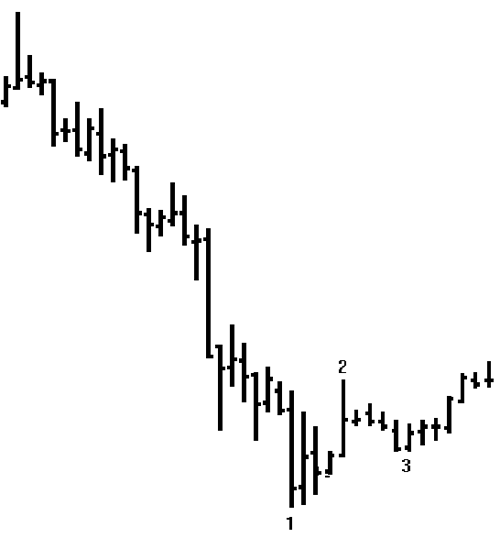
DON'T LET A SETBACK GET YOU DOWN
Joe Ross (Newsletter No. 544)
If you want to become a winning trader, you must be willing to face losses without letting them get you down. Upon facing a loss, our first inclination is to feel disappointed, but how you react emotionally is merely a matter of how you look at matters. If you go in with unrealistically high hopes, you'll feel devastated when you encounter a setback. If you expect a setback here and there, however, you'll feel at ease and ready to bounce back quickly when you're knocked down. A top-notch salesperson may make a sale on only one out of ten cold calls. And a winning trader can come out ahead even if the majority of trades executed are losers. One of my broker/trader friends wins only 27% of his trades, but makes lots of money every year. It's daunting to think about it, but you may see many more failures than successes on your way to becoming a seasoned, master trader.
Experienced traders know how to take losses and setbacks in stride. They don't mull over past defeats, or trading losses. They see a setback as an opportunity to improve their skills, and grow. They examine what they did wrong, learn from their mistakes, and view a temporary setback as a launch pad from which to achieve higher future performance. With proper risk management, you can win as few as four trades out of a dozen and still come out ahead. Rather than getting bogged down with self-doubt, regret, and defeat, winning traders use a "loss" as a motivator for change and improvement.
How can you afford to take loss after loss and be happy about it? It isn't easy. Obviously, if you are losing big over and over again, you'll blow out quickly, and every loss will make you feel even more discouraged and beaten. To feel safe and at ease, you must believe that you can survive the learning curve. Risk management is vital for your survival. Limit your risk on any single trade. In addition, trade selectively. Only take setups where you can potentially make a large profit with relatively little risk. That's still not enough, however. If you don't improve, you'll still end up in the red. You must feel that your skills are in constant flux in order to take losses in stride.
Market conditions and your mood can impact your trading performance. If you trade in market conditions where you have trouble making a profit, you'll feel stressed out and you will likely choke under the pressure. It's better to trade under conditions where you are comfortable most of the time.
Your first priority should be on making enough winning trades to profit overall. Even then, you might see more losing trades than winners. But once you feel secure that you can make profits, you'll be able to explore new territory with little fear. Once you know that you have a basic set of skills, you'll be able to take losses in stride. So when you feel beaten, focus on the big picture. As long as you manage risk and continue to improve your skills, you'll eventually master the markets. In the context of the big picture, the losses here and there are just part of the learning experience. As long as you achieve profitability in the end, occasional losses are nothing to worry about.
Yours,
Joe Ross
EXCHANGE TRADED FUNDS (ETFs)
Joe Ross (Newsletter No. 545)
I received a question on our Forum asking whether or not the Law of Charts works with exchange trade funds.
The answer is yes as you can see from the weekly chart below. The chart shown is ProShares UltraShort Euro, traded at the NYSE. The fund rises when the euro falls, and falls when the euro rises. The chart shows the entry on a breakout from a Trading Range on exactly the 29th weekly bar. The breakout is that very long bar (arrow) you see as prices break through the Trading Range and close below. The Law of Charts states that breakouts from consolidations are most likely to occur on bars 21-29.
The arrow shows a potential entry via a Traders Trick that was nullified because of the gap open.
Yours,
Joe Ross
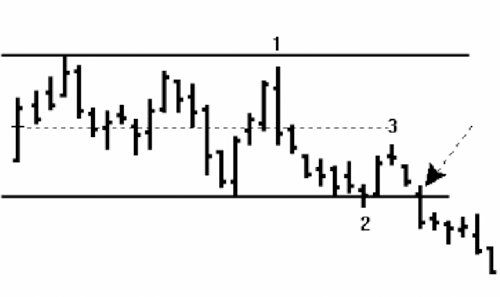
DARE TO BE AVERAGE
Joe Ross (Newsletter No. 545)
When you put your money on the line, there's a strong need to seek out perfection. Many novice traders believe they can get everything just right. They believe that they can locate infallible information, find the perfect setup, and execute every trade flawlessly. In "Trading in the Zone," Mark Douglas notes that many traders are so consumed with making the perfect trade that they never get around to executing enough trades to make a profit. It may be difficult to accept for the overly compulsive trader, but trading is not a profession where you can persistently demand perfection. There's no such thing as a sure profit. Information is often inaccurate. You can plan a trade methodically only to have it fail because an unanticipated adverse event thwarts your trading plan. It's natural to strive for perfectionism. You don't want to be a sloppy, impulsive trader. That said, you don't want to be an extreme perfectionist either.
The harder you strive for perfectionism, the worse your disappointment will become. Perfectionism has more disadvantages than advantages. When you strive for overly exacting standards, you feel so tight and nervous that you actually aren't very productive. You are unable to take risks because you fear failure. You tend to hold back rather than make new discoveries. Trading is a profession where you must take risks and explore new market opportunities. If you continuously strive for perfectionism, you'll never feel satisfied. You'll always think, "I could have done better."
Is your perfectionism out of hand? Here's an exercise for learning about the impact of your perfectionism: Dare to be average. Feel what it is like to be average and see what happens. Rather than search for the ideal setup, why not just find a profitable setup? What happens when you just make an average trade? Sure you won't make as much profit, but you might feel better. You will probably feel relaxed. Compare what it feels like to strive for high standards, moderate standards, and low standards. You may find that merely going for moderate standards makes you feel better. You may also find that you put on more trades, and achieve greater levels of profitability. Trading can be a matter of probabilities.
To get the law of averages to work in your favor, you must make trade after trade. If you manage your risk, and put in a moderate effort, you can make enough trades to come out ahead. As long as the setups are reasonable, and you are using sound trading strategies, you can get the losing trades "out of the way" and focus on the winning trades. But if you are an extreme perfectionist, you'll always be on edge and unable to make trades. And because you are so concerned with overly high standards, you may never discover and take advantage of new, profitable market opportunities. By easing up, you'll feel more relaxed and creative. Ironically, you may end up more profitable by daring to be average, instead of striving for absolute perfection. So dare to be average and see what happens. You may be surprised at what you find.
Yours,
Joe Ross
SPREADS
Joe Ross (Newsletter No. 546)
Lean Hogs couldn't seem to go up. Prices flat-lined from September into October. But that wasn't the case for Live Cattle. It, too spent a number of days going sideways, but prices broke out of congestion and began to move up offering a nice profit to those who were long cattle and short hogs. Earlier in the year, August cattle prices rose, while at the same time hog prices fell, offering up a perfect long cattle short hog spread. A perfect spread occurs when the long side moves up and short side moves down. This is an ideal situation for creating a spread between the two.
You can see the spread line begin to rise in early July, and again in late September.
It is of no importance whether the spread is seasonal or not. The fact is that it can be entered simply my mere observation: Prices flat on one hand and prices rising on the other, or prices rising on one hand and prices falling on the other.
Yours,
Joe Ross

Getting It Right--When did the E-Mini S&P 500 (ES) become
a bear market?
Joe Ross (Newsletter No. 547)
S&P 500 Future (ES) turned into a bear, when prices broke below the first Ross Hook (RH) on the chart. The violation of the #2 point of a 1-2-3 formation defines (DT) a trend. A violation of the first Ross Hook (RH) that follows establishes (ET) the trend. Above you see an established downtrend followed by a second RH, and a Traders Trick Entry (TTE).
Yours,
Joe Ross
THE INTUITIVE MIND
Joe Ross (Newsletter No. 547)
Have you ever seen a pattern emerge, and you instinctively trusted your gut instinct even though your logical mind told you otherwise? Sometimes it works, but other times your intuition may fail you. Scientists are fascinated by how people use intuition. There's something intriguing and mystical about it. Intuition helps us make quick and rapid decisions without full conscious awareness, but sometimes it's wrong.
Trading is a matter of probabilities. We find a method that has a statistical edge and use that method over and over so that the law of averages will work in our favor. But there are times when we forget about probabilities and go with our gut instinct. Our intuition is often influenced by emotions.
Intuition is powerful, but it's vital to learn to overcome your intuition when you suspect that it may lead you astray.
Experienced traders rely on their intuition to make winning trades by quickly and efficiently capitalizing on the market action, but if you're a novice trader, your intuitive skills are probably not yet developed. Whether you are trying to identify the emergence of a pattern with technical analysis or trying to read the tape using price and volume, your intuitive skills may lead you astray. Intuitively, you may think the price will move in a particular direction, and your emotions may want it to, but it doesn't happen.
As you gather a wealth of experience, your intuitive skills will develop, but until then, it's wise to be a little skeptical. Don't unnecessarily stand aside or lose confidence. Continue to make trades, but don't risk too much on a given trade. If you ignore your risk management rules as a novice trader, you'll take big hits to your account. Your skills are not yet developed, and until they are, managing risk allows you to survive the learning curve. Mastering the markets takes time and experience. Eventually, you'll develop the intuitive skills to trade quickly and decisively, but until then, stay cautious and disciplined.
Yours,
Joe Ross
CCI (Commodity Channel Index)
Joe Ross (Newsletter No. 548)
The chart below was sent to me by one of my students in Brazil. I have no idea which market is represented by this chart. I know only that it is a daily chart and it is showing a 30 bar Commodity Channel Index (CCI).
The CCI plot is generally graphed around a value of 0, with one line being fixed at +100 and another line being fixed at -100 . There are many ways to use the CCI. Generally it is used as an overbought/oversold indicator, but in my opinion it is much better used as trend following indicator. I don't want to get into all the detail here concerning the best uses of CCI. The point is to show you that The Law of Charts works equally as well with indicators as it does with price bars. The way CCI is used on this chart was as a means of following the long move up.
If you want to use CCI to follow a trend the way I have done it for many years, and also have access to the formula for computing CCI, you will find it contained in my manual "Trading The Ross Hook."
CCI, in case you are wondering, represents the Mean Deviation of today's typical price from a moving average of typical prices. It is very similar in nature to the calculation for Bollinger bands but is plotted as an oscillator rather than as an overlay.
Typically, once prices have crossed all 3 lines, from -100, past 0, and then +100, you stay in the trend until you re-cross the 0 line. Unfortunately, the chart doesn't show exactly where the 0 line is located.
Do notice that the Law of Charts formation appears on the CCI indicator itself with a 1-2-3 Low, followed by some Ross Hooks.
Yours,
Joe Ross
VISUALIZING THE TRADE
Joe Ross (Newsletter No. 548)
Before the opening bell rings, you may have clearly outlined your trading plan. You know where you will enter, and which signals will indicate the plan has gone sour. But when you try to execute the trade a few hours later, you find that you can't control your emotions. You enter, the market moves against you, and you panic. Stuck and frozen, you don't exit as you had planned. The market continues moving against you, and you lose more money than you had planned.
Rather than unnecessarily mounting losses, you can improve your performance by visualizing the trade before it happens.
Whether it's perfecting a golf stroke or improving a backswing, visualization can be used effectively to fine-tune a variety of skills. Many winning traders use visualization to prepare for a trade before it happens. In your mind, you can play and replay the trade. You can pretend to look at indicators on your screens and interpret the market action. You can experience the thoughts and emotions you'll feel as you watch the market action. You can allow your mind to visualize the precise movements your body makes as you click the mouse. Visualization is the next best thing to being there.
Visualization is based on the principle that a great deal of learning occurs in your mind, even if the activity is largely physical rather than mental. When playing sports, for example, it's possible to actually improve your skills by mentally rehearsing each action. Your body and mind can learn just by going through the motions mentally. You can replay an action. For example, you can pretend a tennis opponent hit a ball toward you, and you can imagine graciously returning it. You can imagine what you are thinking and feeling. You can practice over and over, and as you do, you'll sharpen your skills.
Visualization allows an athlete or a trader to prepare for how he or she might react to different scenarios. A trader can imagine what it feels like to execute a trade when the market is going against him or her, for example. You can pretend it is happening and feel the initial disappointment you might have. But rather than act impulsively, you can visualize acting calmly, and closing out the position. In the heat of the moment, without practice, you may be stunned and paralyzed. With visualization, in contrast, you can practice what you would do over and over again.
You can practice monitoring your internal dialog. You can practice thinking, "The loss is no big deal. I've used risk management to cover the loss. Losses are an everyday event when you're a trader. I'll just stay calm and follow my trading plan." It helps to practice a stressful trading event in your mind before it happens. You'll learn to control your muscles, your thinking, and your emotions. Why try to practice this complicated set of actions during the trading day when all you do is choke? Do it off hours to prepare for the trading day. By using visualization, you can improve your trading skills during off hours until you trade calmly, decisively, and profitably.
Yours,
Joe Ross
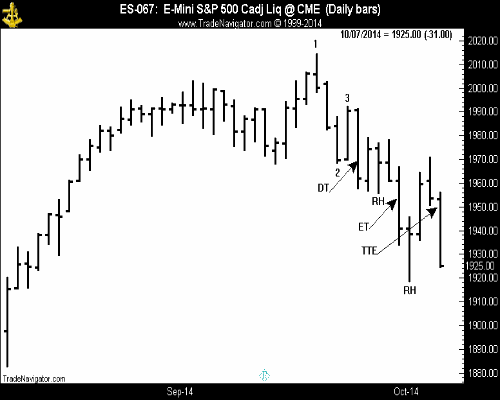
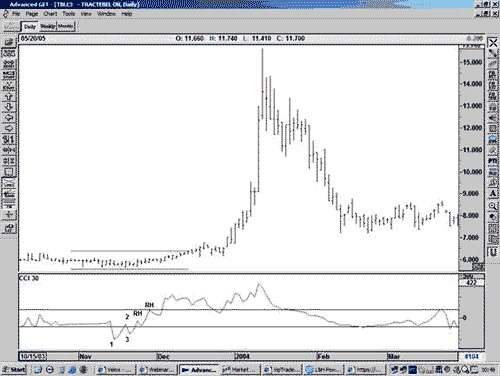
BRITISH POUND
Joe Ross (Newsletter No. 549)
This week I want to show you a trade made in the British Pound, U.S. Dollar forex pair. To trade it I would have had to be a midnight cowboy. However, I was fast asleep when it was made. The person who sent it to me trades from the U.K., and it was early morning there when the trade was made.
I get a kick out of seeing people in various parts of the world using the Law of Charts to make money in the markets. Part and parcel with the Law of Charts is the implementation of the "Law" using the Traders Trick Entry (TTE). Please be sure you read through and study the free E-book PDF you downloaded for "The Law of Charts and Traders Trick Entry," which you received complimentary with your free Chart Scan subscription.
There is nothing complicated about the trade shown on the chart attached (60 Minute GBP-USD Entry made at 07:00 UK Time). The trader was looking for the trend and so he waited for prices to move past the #2 point and then he took a Traders Trick Entry ahead of the breakout of the Ross hook. He wrote that he took some profits near the high of the bar that moved past the hook, and cashed the rest of his position at the close of the price bar that made the high. His reason was that he was satisfied with what he got from the trade. This reminds me of the way many professionals trade. They are not looking to "shoot the moon." They have set objectives and they exit when those objectives are reached. Doing so takes discipline and self-control, two ingredients needed by every trader who desires to become successful in this business.
Yours,
Joe Ross
MEDIA NEWS AND THE BEHAVIOR OF THE MASSES
Joe Ross (Newsletter No. 549)
As a short-term trader, your goal is to stay ahead of the crowd and let their money flow from their pockets into yours. The better you can anticipate the behavior of the masses, the better you'll be able to capitalize on their irrational decisions. The masses are notorious for over-reacting to media news.
A popular theory in behavioral economics is that buying and selling by the masses is motivated by a powerful tendency to avoid regret and seek out pride. These emotional tendencies often lead to irrational investment decisions. Many investors, for example, hold on to a losing investment because they don't want to face feelings of failure and regret. Keeping losses on paper postpones the inevitable. Good news raises stock prices, and when prices rise as a result of good news, most investors can't wait to sell, take profits, and bask in the glory of success.
However, a professional study revealed that things may be a little more complicated. It may depend on the kind of news investors hear, rather than whether it is good or bad. The study showed how investors reacted to two kinds of news, news about specific companies and news about the economy in general.
Good news, whether it is about a specific company or about the economy in general, increases stock prices. And you would think that regardless of what kind of news raises a stock price, the impact on the masses would be the same. But the study found that the kind of news does matter. If the good news is about the specific company, the masses tend to sell, but if the good news is general economic news, they hold on to their positions. Bad news about the economy similarly has little effect on what the masses do according to the study.
What are the psychological dynamics behind the behavior of the masses? In their pursuit of pride and avoidance of regret, the masses continually monitor their positions and deliberate as to whether they have made a good or a bad investment. If the news is bad about a company, they tend to blame themselves for choosing the wrong company in which to invest. They tend to believe that they could have cherry picked a better company had they done their homework. When they hear good or bad economic news about a company, it bears on their original decision to invest in the company, and they react emotionally. On the other hand, it's hard to blame yourself for a poor economy. What could you have done? A poor economy impacts all stocks, so the only thing you could have done was to avoid investing in the market altogether. It wouldn't matter what company an investor decided to put their money in since all companies are affected by a poor economy. In this case, the masses forgive themselves, and do nothing.
The influence of emotions on the masses is powerful. By seeking out pride and avoiding regret, they allow their emotions to overpower their logic. As an astute trader, however, it's vital that you stay objective. Don't let your feelings of pride or regret influence you. Let the masses over-react. And when they do, capitalize on their irrational behavior and profit from it.
Yours,
Joe Ross
